Advantech Co MITW101A1 Computer User Manual
Advantech Co Ltd Computer
User Manual
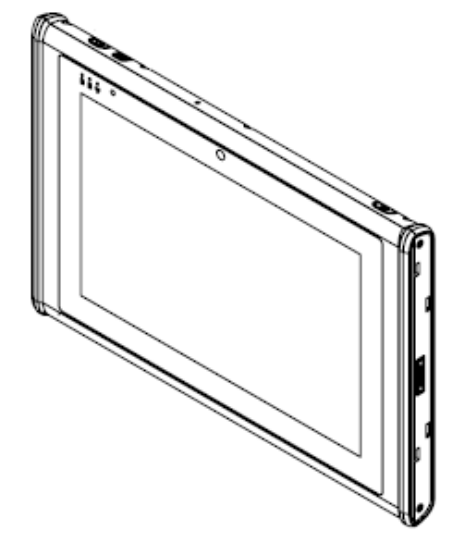
1
Mobile Computer
MIT-W101-A
User Manual
Ver 1.0
MIT-W101-A
2
Copyright
The documentation and the software included with this product are copyrighted
2014 by Advantech Co., Ltd. All rights are reserved. Advantech Co., Ltd. reserves
the right to make improvements in the products described in this manual at any time
without notice. No part of this manual may be reproduced, copied, translated or
transmitted in any form or by any means without the prior written permission of
Advantech Co., Ltd. Information provided in this manual is intended to be accurate
and reliable. However, Advantech Co., Ltd. assumes no responsibility for its use, nor
for any infringements of the rights of third parties, which may result from its use.
Acknowledgements
All other product names or trademarks are properties of their respective owners.
Intended use
The MIT-W101 is intended for integration with hospital system. It is designed for general
purpose for hospital environment. For data collection and display for reference.
It shall not be used for life-supporting system.
3
Declaration of Conformity
CE Conformity Statement
Radio products with the CE alert marking comply with the R&TTE Directive
(1999/5/EC) issued by the Commission of the European Community. Compliance
with this directive implies conformity to the following European Norms (in brackets
are the equivalent international standards).
• EN 60950-1 (IEC60950-1) - Product Safety
• EN 300 328 Technical requirement for radio equipment
• ET S301 489 General EMC requirements for radio equipment
Products that contain the radio transmitter are labeled with CE alert marking and
may also carry the CE logo.
MIT-W101-A User Manual
FCC Compliance Statement
This device complies with part 15 of the FCC Rules. Operation is subject to the
following two conditions:
1. This device may not cause harmful interference;
2. This device must accept any interference received, including interference that
may cause undesired operation.
This equipment has been tested and found to comply with the limits for a Class B
digital device, pursuant to part 15 of the FCC Rules. These limits are designed to
provide reasonable protection against harmful interference in a residential
installation. This equipment generates uses and can radiate radio frequency energy.
If this equipment does cause harmful interference to radio or television reception,
which can be determined by turning the equipment off and on, the user is
encouraged to try and correct the interference by one or more of the following
measures:
However, there is no guarantee that interference will not occur in a particular
installation. If this equipment does cause harmful interference to radio or television
reception, which can be determined by turning the equipment off and on, the user is
encouraged to try to correct the interference by one or more of the following
measures:
• Reorient or relocate the receiving antenna
• Increase the separation between the equipment and receiver
• Connect the equipment into an outlet on a circuit different from that to which the

4
receiver is connected
• Consult the dealer or an experienced computer technician for help
Warning! Any changes or modifications made to the equipment
which are not expressly approved by the relevant standards
authority could void your authority to operate the equipment.
Caution! Danger of explosion if battery is incorrectly replaced.
Replace only with the same or equivalent type recommended by
the manufacturer. Dispose of used batteries according to the
manufacturer's instructions.
This equipment complies with FCC RF radiation exposure limits set forth for an
uncontrolled environment for body-worn configuration in direct contact to the
phantom.
This device complies with FCC radiation exposure limits set forth for an uncontrolled
environment.
Technical Support and Assistance
1. Visit the Advantech website at http://support.advantech.com
where you can find
Caution! Exposure to Radio Frequency Radiation.
The radiated output of this device is far below the FCC radio
frequency exposure limits. Nevertheless, the device shall be used in
such a manner that the potential for human contact during normal
operation is minimized.
MIT-W101-A User Manual I the latest information about the product.
2. Contact your distributor, sales representative, or Advantech's customer service
center for technical support if you need additional assistance. Please have the
following information ready before you call:
– Product name and serial number
– Description of your peripheral attachments
– Description of your software (operating system, version, application software,
etc.)
– A complete description of the problem
– The exact wording of any error messages
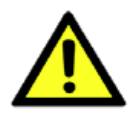
5
Safety Instructions
1. Read these safety instructions carefully.
2. Keep this user manual for later reference.
3. Disconnect this equipment from AC outlet before cleaning. Do not use liquid or
spray detergents for cleaning.
4. For plug-in equipment, the power outlet socket must be located
near the equipment and must be easily accessible.
5. Keep this equipment away from humidity.
6. Put this equipment on a reliable surface during installation.
Dropping it or letting it fall could cause damage.
7. The openings on the enclosure are for air convection. Protect the equipment
from overheating. DO NOT COVER THE OPENINGS.
8. Do not leave this equipment in an environment unconditioned where the
storage temperature under -20C or above 60C, it may damage the
equipment.
9. Make sure the voltage of the power source is correct before connecting the
equipment to the power outlet.
10. Place the power cord such a way that people cannot step on it. Do not place
anything over the power cord. The voltage and current rating of the cord
should be greater than the voltage and current rating marked on the product.
11. All cautions and warnings on the equipment should be noted.
12. If the equipment is not used for long time, disconnect it from the power
source to avoid being damaged by transient over-voltage.
13. Never pour any liquid into ventilation openings. This could cause fire or
electrical shock.
14. Never open the equipment. For safety reasons, the equipment should be
opened only by qualified service personnel.
15. If any of the following situations arises, get the equipment checked by service
personnel:
a. The power cord or plug is damaged.
b. Liquid has penetrated into the equipment.
c. The equipment has been exposed to moisture.
d. The equipment does not work well or you cannot get it to work according to
user manual.
e. The equipment has been dropped and damaged.
f. The equipment has obvious signs of breakage.
16. CAUTION: The computer is provided with a battery-powered real-time clock
circuit. There is a danger of explosion if battery is incorrectly replaced.
Replace only with same or equivalent type recommended by the manufacture.
Discard used batteries according to the manufacturer’s instructions.
17. If your computer is losing time significantly or the BIOS configuration resets
itself to the default, the battery may have no power.
Caution! 1. Do not replace battery yourself. Please contact a
qualified technician or your retail provider.
2. The computer is provided with a battery-powered real-time clock
circuit. There is a danger of explosion if battery is incorrectly
replaced. Replace only with same or equivalent type recommended
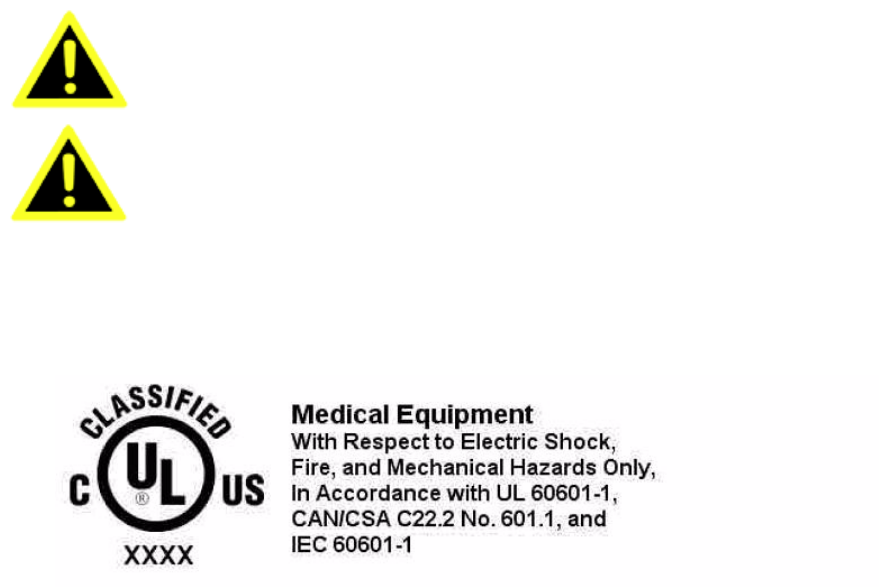
6
by the manufacturer. Discard used batteries according to the
manufacturer's instructions.
18. CLASSIFICATION:
Supply Class I adapter
No applied part
Continuous Operation
Not AP or APG category
19. Disconnect device: Appliance inlet.
20. Follow national, state or local requirements to dispose of
unit.
21. Maintenance: to properly maintain and clean the surfaces,
use only the approved products or clean with a dry applicator.
22. Contact information:
No.1, Alley 20, Lane 26, Rueiguang Road Neihu District, Taipei, Taiwan 114,
R.O.C.
TEL: +886 2-2792-7818
23.
24. This equipment shall not be used as a life support system.
25. Accessory equipment connected to the analog and digital interfaces must be in
compliance with the respective nationally harmonized IEC standards (i.e. IEC
60950 for data processing equipment, IEC 60065 for video equipment, IEC
61010-1 for laboratory equipment, and IEC 60601-1 for medical equipment.)
Furthermore all configurations shall comply with the system standard IEC
60601-1-1. Anyone who connects additional equipment to the signal input part
or signal output part is configuring a medical system, and is therefore,
responsible that the system complies with the requirements of the system
standard IEC 60601-1-1. The unit is for exclusive interconnection with IEC
60601-1 certified equipment in the patient environment and IEC 60XXX
certified equipment outside of the patient environment. If in doubt, consult
the technical services department or your local representative.
26. Users must not allow SIP/SOPs to come into contact with the patient at the
same time.
27. The sound pressure level at the operator’s position according to IEC 704-1:1982
is no more than 70dB (A).
28. “WARNING - Do not modify this equipment without authorization of the
manufacturer.”
29. “WARNING – To avoid risk of electric shock, this equipment must only be
connected to a supply mains with protective earth.
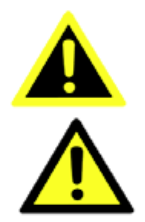
7
30. WARNING:Pleaseavoidhavingenclosuretocontactwithskinmorethan1
minute.
31. CAUTION! This product: MIT-W101-A is only used with the
qualified & certificated power adapter: SINPRO ELECTRONICS CO
LTD, model MPU63A-107. Output: 18Vdc, 3.5A max
DISCLAIMER: This set of instructions is given according to IEC 704-1. Advantech
disclaims all responsibility for the accuracy of any statements contained herein.
Battery Safety
RTC Battery Caution
RISK OF EXPLOSION IF BATTERY IS REPLACED BY AN INCORRECT TYPE.
DISPOSE OF USED BATTERIES ACCORDING TO THE INSTRUCTIONS.
Do not place the battery incorrectly as this may cause danger of explosion.
Dispose of used batteries according to the manufacturer's instructions.
Do not dispose of batteries in a fire. They may explode. Check with local
authorities for disposal instructions.
Battery Pack Caution
The battery used in this device may present a risk of fire or chemical burn if
mistreated. Do not disassemble, heat above 40°C, or incinerate. Replace standard
battery pack with Advantech MIT-W101-BATC Li-ion 11.1V 2860mAh. Use of another
battery may present a risk of fire or explosion.
Dispose of used batteries according to local disposal regulations. Keep away from
children. Do not disassemble and do not dispose of in a fire.
Battery Charge Notice
It is important to consider the environment temperature whenever you are charging
the Lithium-Ion battery pack. The process is more efficient at normal room
temperature or slightly cooler. It is essential that you charge batteries within the
stated range of 0°C to 35°C. Charging batteries outside of the specified range could
damage the batteries and shorten their charging life cycle.
Storage and Safety Notice
Although charge Lithium-Ion batteries may be left unused for several months, their

8
capacity may be depleted due to the buildup of internal resistance. If this happens
they will require recharging prior to use. Lithium-Ion batteries may be stored at
temperatures between -20°C to 60°C, however they may be depleted more rapidly
at the high end of this range. It is recommended to store batteries within normal
room temperature ranges.
Disposing of Batteries or Battery Pack.
Batteries, battery packs, and accumulators should not be
disposed of as unsorted household waste.Please use the
public collection system to return, recycle, or treat them in
compliance with the local regulations.
Chapter 1 Ready to Go.........................................................................................11
1.1 Symbols Used in this Manual.................................................................................13
1.2 Product Features....................................................................................................13
1.3 Package Contents...................................................................................................13
1.4 Optional Modules...................................................................................................14
1.5 System Configuration.............................................................................................14
1.6 Exploring the MIT-W101-A.....................................................................................16
9
1.6.1 Front View .......................................................................... 16
1.6.2 Rear View ........................................................................... 17
1.6.3 Right View ........................................................................... 18
1.6.4 Left View ............................................................................ 18
1.6.5 Top View ............................................................................ 19
1.6.6 Bottom View ........................................................................ 19
Chapter 2 Making Connections............................................................................20
2.1 Connecting the Power...........................................................................................21
2.2 Connecting to a Monitor........................................................................................21
2.3 Connecting USB Devices........................................................................................22
2.4 Connecting Headphones........................................................................................22
2.5 Connecting a Microphone......................................................................................23
Chapter 3 Turning On...........................................................................................24
3.1 Controlling the MIT-W101-A..................................................................................25
3.1.1 Using the Touch Screen.....................................................................................25
3.1.2 Using the Tap Function ............................................................ 25
3.1.3 Using the Control Panel Buttons ................................................. 25
3.1.4 Using the On-Screen Keyboard ................................................... 26
3.1.5 Adjusting Screen Brightness ...................................................... 28
3.1.6 Adjusting the Volume.............................................................. 29
Chapter 4 Wireless Connections.........................................................................33
4.1 Wi-Fi Connection....................................................................................................34
4.2 Bluetooth Connections..........................................................................................37
4.2.1 Setting Up Bluetooth .............................................................. 37
Chapter 5 Advance Setting..................................................................................40
5.1 Checking Battery Status........................................................................................41
5.2 Maintenance...........................................................................................................41
5.2.1 Maintaining the Battery ........................................................... 41
10
5.2.2 Maintaining the LCD Display ...................................................... 42
5.2.3 Cleaning the MIT-W101-A ......................................................... 42
5.3 Trouble Shooting ..................................................................... 42
Immunity test.................................................................................................................44
Chapter 6 Dashboard Installation & Hotkey setting.........................................46
6.1 Installation..............................................................................................................47
6.1.1 Extract file “MIT-W101-Dashboard v1.0.0 ...................................... 47
6.1.2 Follow the procedure to install the dashboard ................................ 48
6.1.3 Install completed and re-start MIT-W101 ....................................... 50
6.2 Start to use.............................................................................................................51
6.2.1 Click icon of “Advantech Control Center” ...................................... 51
6.2.2 Barcode reader ..................................................................... 51
6.2.3 MSR (enable with expansion module / MIT-W101-ACCEM000E).............. 54
6.2.4 Smart Card (enable with Expansion module) .................................. 55
6.2.3 NFC ................................................................................... 56
6.2.4Camera .................................................................................... 59
6.2.5 Brightness ........................................................................... 60
6.2.6 Hotkey Setting ...................................................................... 61
Appendix Specifications.......................................................................................63
A.1 Specifications.........................................................................................................64
A.2 Optional Accessories.............................................................................................66
A.2.1 External Battery.................................................................... 66
A.2.2 Docking Station ..................................................................... 67
A.2.3 Expansion Module .................................................................. 70
A2.3.1 Installing an Expansion module ................................................. 71
A2.4 Rubber Bumpers ..................................................................... 72
A2.4.1 Installing the Rubber Bumpers .................................................. 72
11
A2.4.2 Removing the Rubber Bumpers ................................................. 73
A.3 Installing an SSD.....................................................................................................74
A.3.1.1 Inserting an SSD .................................................................. 74
A.3.1.2 Removing an SSD................................................................. 76
Chapter 1 Ready to Go

12
Congratulations on your purchase of the MIT-W101-A Rugged Tablet PC. This product
combines rugged design with reliable performance and powerful functionality to
best suit all your needs, in a wide range of working conditions. This user manual
outlines all you need to know to set up and use your MIT-W101-A. If you have any
further questions or queries, contact our technical support team via our website:
http://www.advantech.com.tw/
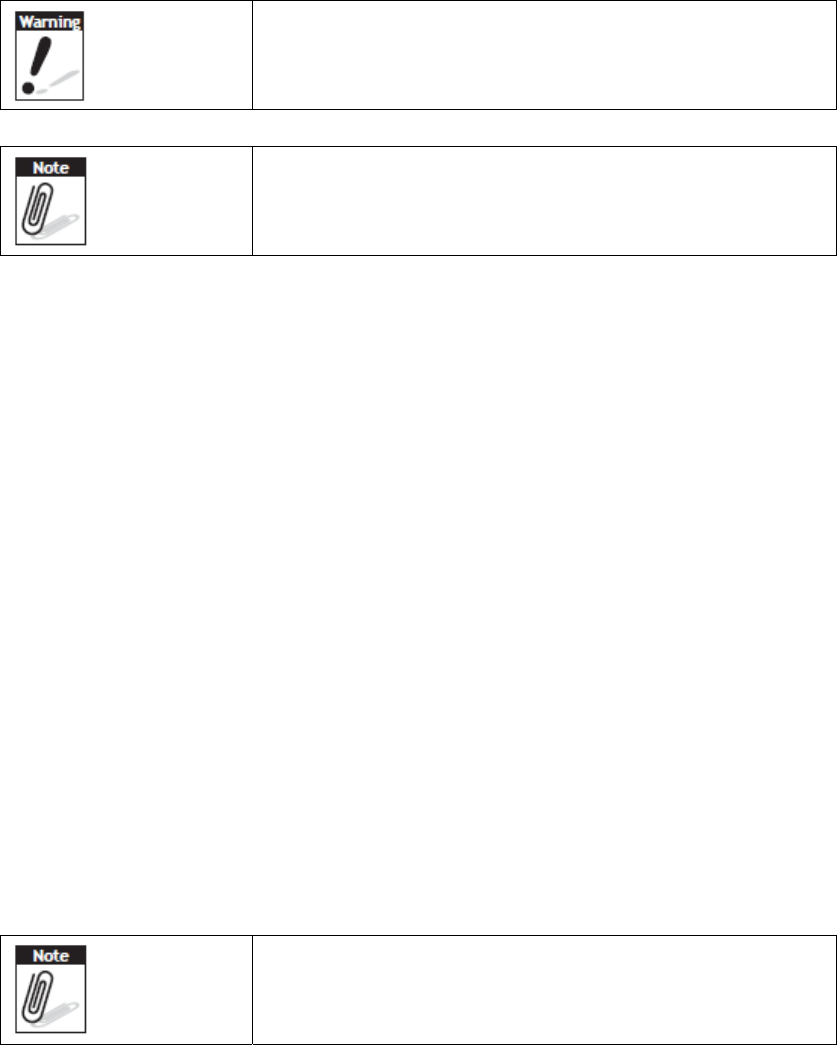
13
1.1 Symbols Used in this Manual
Denotes information that must be observed.
Failure to do so may result in personal harm or damage to
the product.
Denotes information that must be observed.
Failure to do so may result in personal harm or damage to
the product.
1.2 Product Features
• Rugged design.
• Featuring with the Future Intel® Celeron ™ processor for intelligent system.
• Built-in WLAN/Bluetooth/NFC.
• Durable, shock-resistant magnesium alloy housing.
• 10.1 “ WXGA TFT LCD
• Integrated Barcode, NFC and expansion module option of MSR and smart card
Reader.
• Optional accessory to meet 6ft drop and variety of user scenario.
• Power Requirements
DC Input Voltage: 18 V
Power Consumption: less than 60 W
1.3 Package Contents
Ensure all the following items are present when you receive your MIT-W101-A. If any
of these items are missing, contact your vendor immediately.
Screens used in this manual are for illustrative purposes
only. Actual screens may vary depending on your product
version.
• MIT-W101-A Tablet PC
• AC power adaptor
• Battery Pack
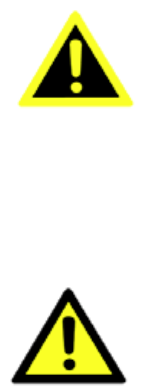
14
Warning! To prevent electric shock, Do not remove cover.
Warning!
1. Input voltage rated 100-240 VAC, 47-63 Hz, 1.62-0.72 A, Output
Voltage rated 18 VDC , max 3.5 A
2. Use a 11 Vdc @ 2860 mA lithium battery
3. Maintenance: to properly maintain and clean the surfaces, use
only approved products or clean with a dry applicator
Caution! 1. Do not replace battery yourself. Please contact a
qualified technician or your retail provider.
2. The computer is provided with a battery-powered real-time clock
circuit. There is a danger of explosion if battery is incorrectly
replaced. Replace only with same or equivalent type recommended
by the manufacturer. Discard used batteries according to the
manufacturer's instructions.
No user serviceable parts inside, refer servicing to qualified personnel.
1.4 Optional Modules
• Barcode Scanner
• Expansion module (MSR and Smart Card Reader)
1.5 System Configuration
TheblockdiagramofaMIT‐W101‐Atabletcomputerisshowninthefollowing
diagram:
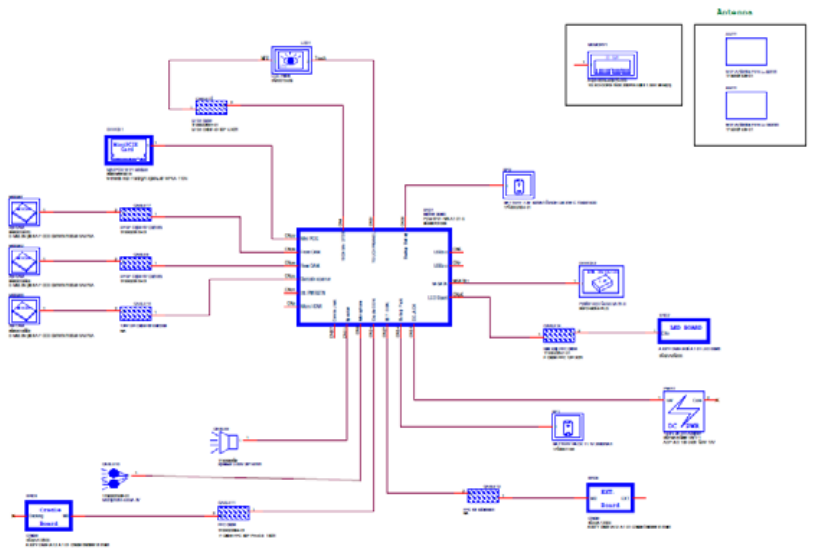
15
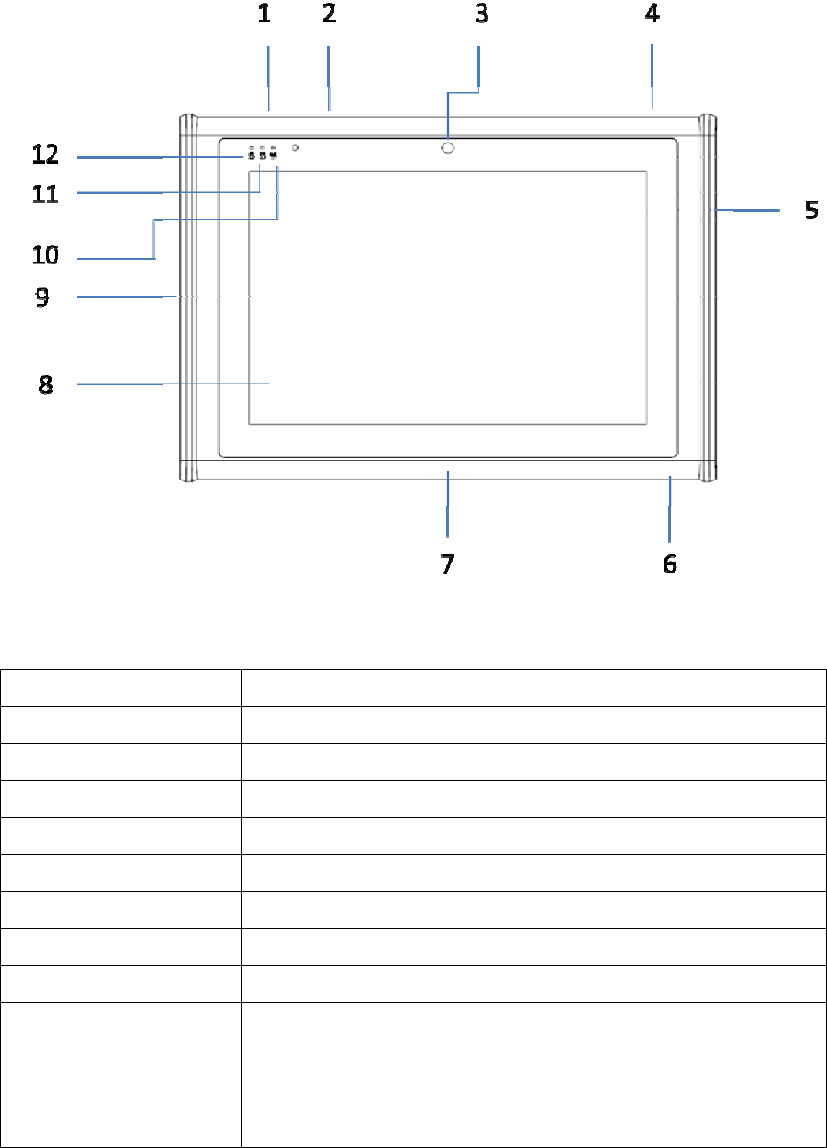
16
1.6 Exploring the MIT-W101-A
1.6.1 Front View
No. Component
1 P1 – Programmable Button
2 P2 - Programmable Button
3 Front Camera
4 Power button
5 Connected to expansion module
6 DC-in jack
7 Docking connector
8 Projective capacitive multiple touch screen
9 I/O ports
• USB 3.0 x 1
• USB 2.0 x 1
• Micro HDMI x 1
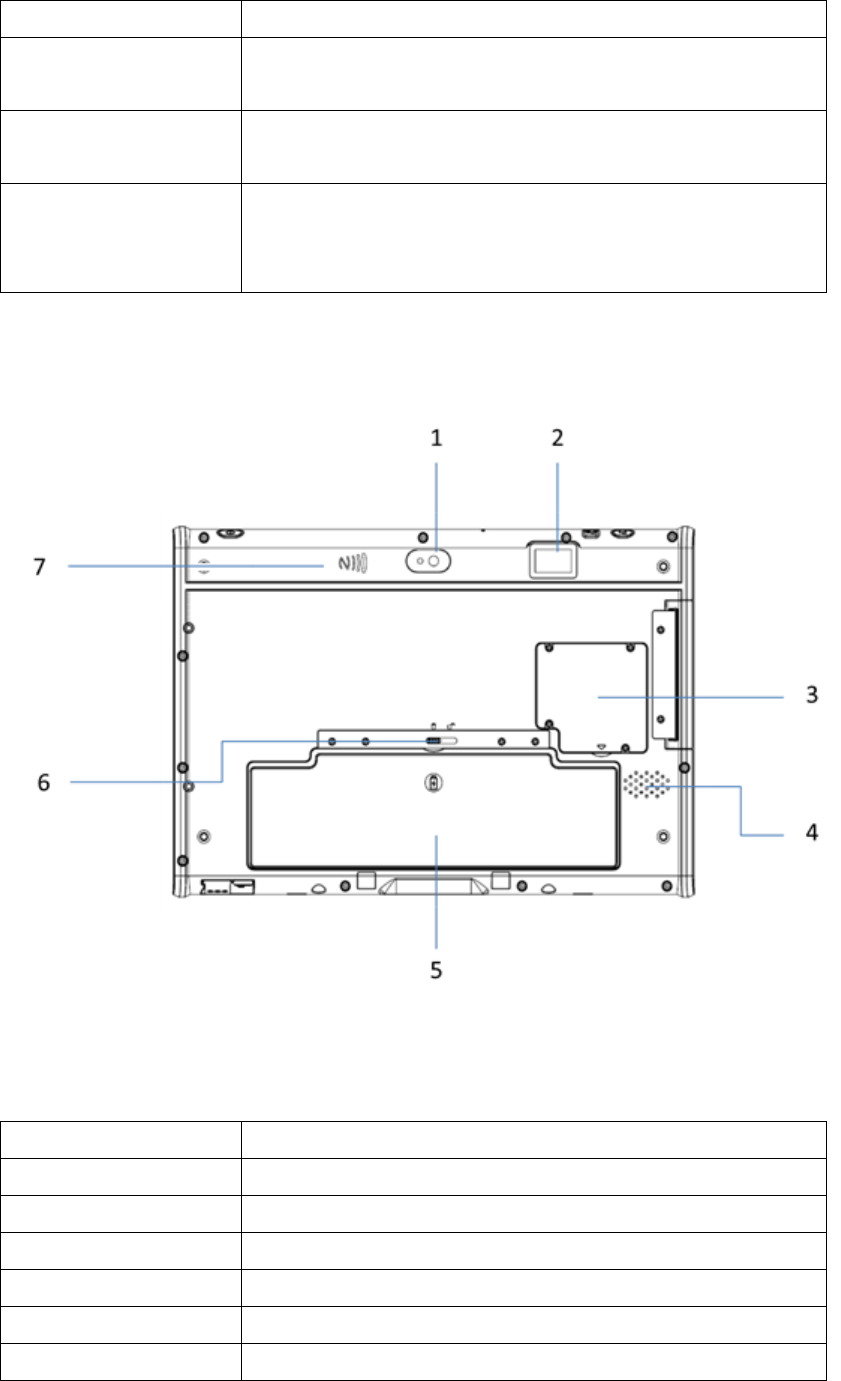
17
• Audio x 1
10 Connectivity LED indicator
• Blue: when Wi-Fi / BT module is on
11 HDD LED indicator
• Blinking green: when hard disk drive is working
12 Power / Battery LED indicator
• Green: Battery is fully charged (>95%)
• Amber : Battery is charging or Battery life is lower than 10%
1.6.2 Rear View
No. Component
1 Back camera
2 Barcode scanner
3 SSD cover
4 Speaker
5 Battery
6 Battery Latch
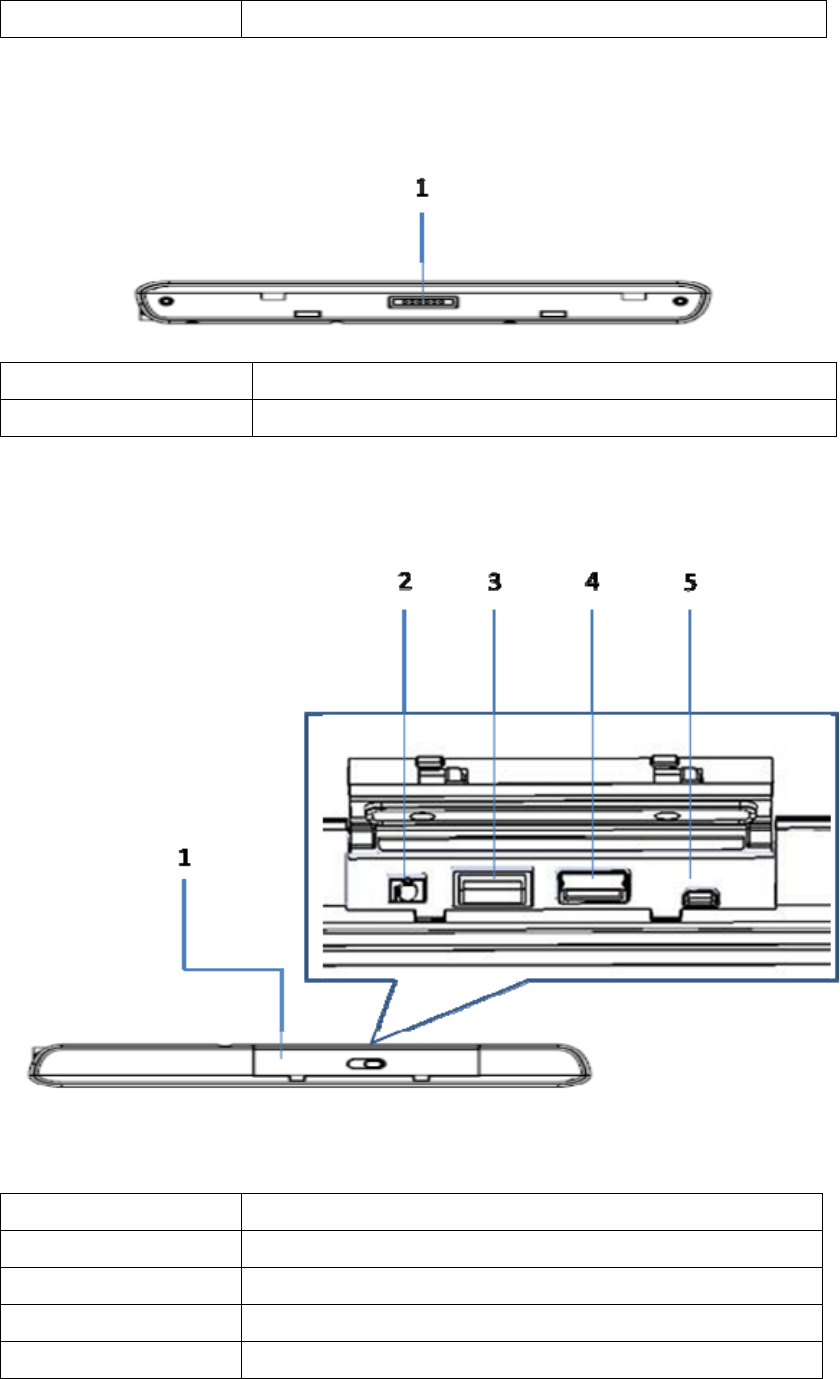
18
7 NFC
1.6.3 Right View
No. Component
1 Connected pin for expansion module
1.6.4 Left View
No. Component
1 I/O ports cover
2 Audio Jack
3 USB 3.0
4 USB 2.0
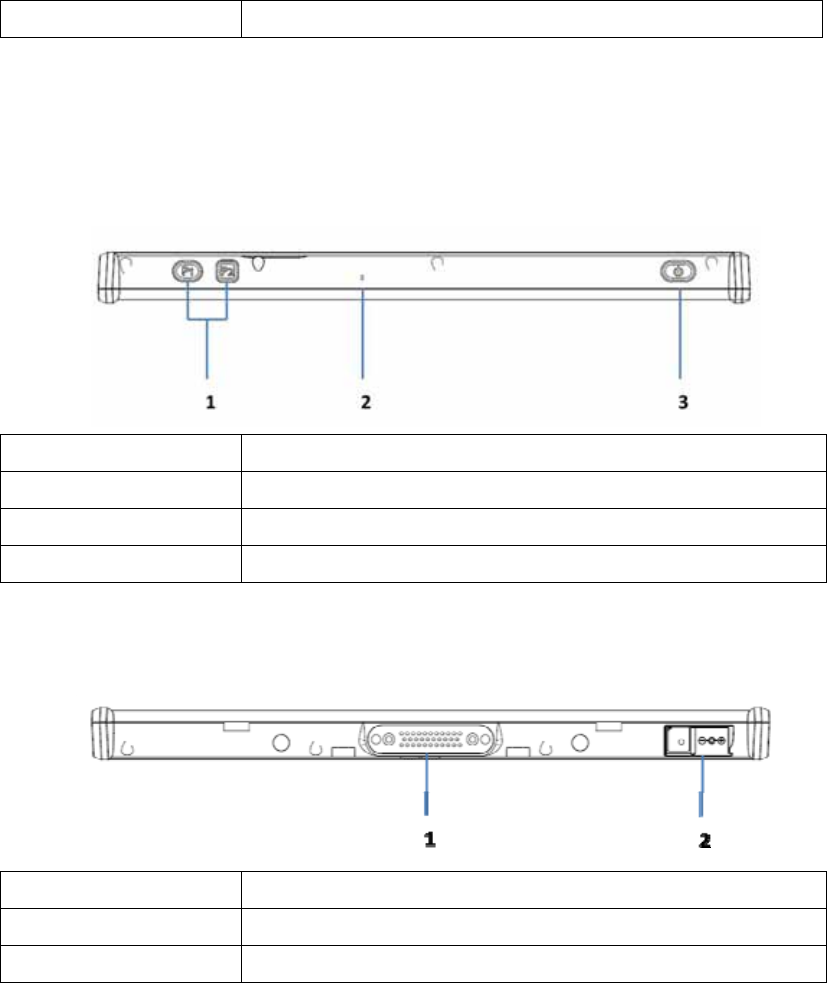
19
5 Micro HDMI
1.6.5 Top View
No. Component
1 Function buttons
2 Built-in MIC
3 Power button
1.6.6 Bottom View
No. Component
1 Docking connector
2 AC-in jack
L
20
Chapter 2 Making Connections
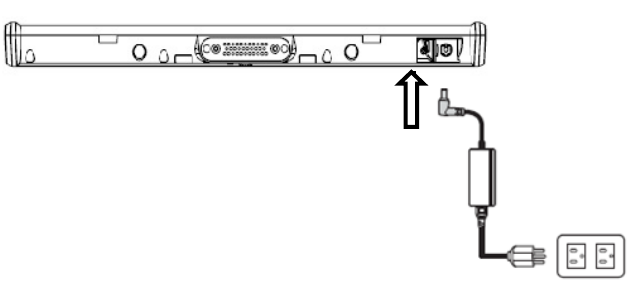
21
2.1 Connecting the Power
Before you can use your MIT-W101-A, you must fully charge the battery. Connect the
power adapter as shown and leave to charge for:
• A minimum of 2 hours when using the internal battery
• A minimum of 4 hours when a second battery is installed
Condition: the operation time is based on the LCD backlight at 50% and the average
utilization of the system under 10%.
Installation Procedures:
1. Connect the female end of the power adapter to the DC-in of MIT-W101-A.
2. Connect the female end of the power cord to the DC power adapter.
3. Connect the 3-pin male plug of the power cord to an electrical outlet.
NOTE: Be sure always handle the power cords by holding the plug ends only.
2.2 Connecting to a Monitor
You can connect the MIT-W101-A to an external monitor for enhanced viewing.
Connect one end of a HDMI to VGA cable to the Micro HDMI port on the left side of
the MIT-W101-A.Connect the other end to the VGA cable and connect to the
monitor.
ToDCInoftheequipment
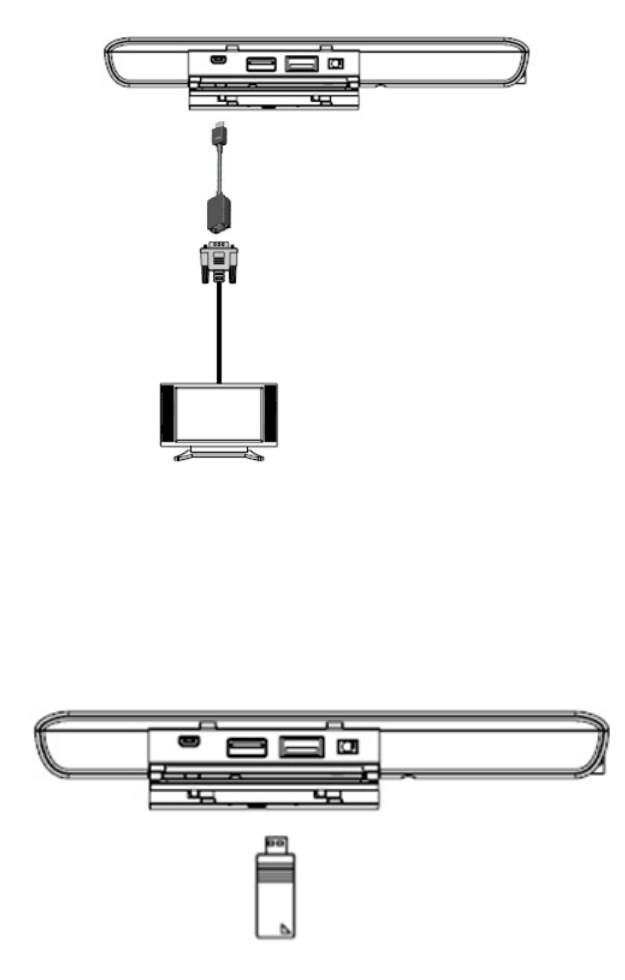
22
2.3 Connecting USB Devices
You can connect peripheral devices, such as a USB keyboard and mouse, as well as
other wireless devices using the USB ports on the left side of the MIT-W101-A.
2.4 Connecting Headphones
You can connect a pair of headphones using the headphone jack on the left side of
the MIT-W101-A.
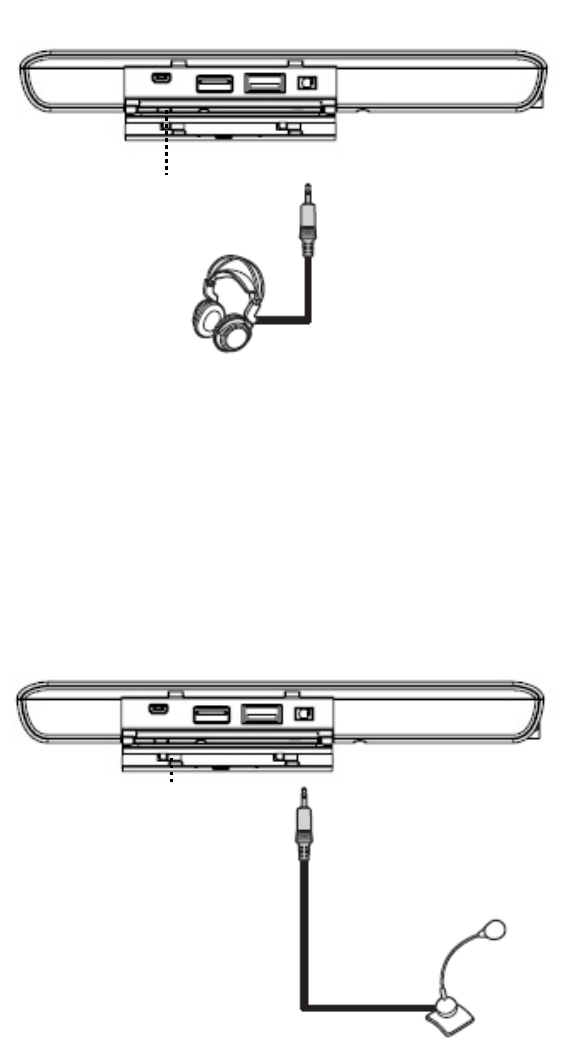
23
2.5 Connecting a Microphone
The MIT-W101-A features a built-in microphone, but you can still connect an
external microphone if needed. Connect the microphone to the microphone jack on
the left side of the MIT-W101-A as shown.
24
Chapter 3 Turning On
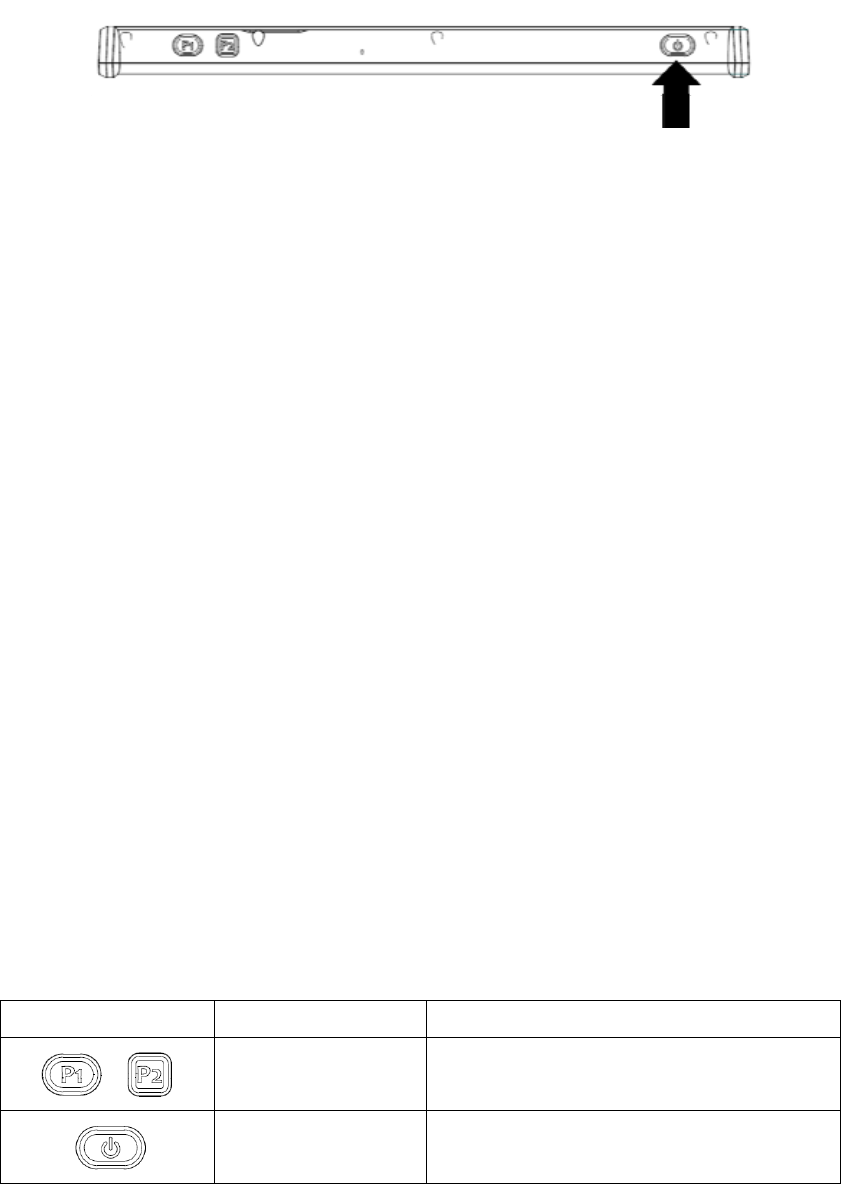
25
1. Press and hold the power button to turn on the MIT-W101-A.
3.1 Controlling the MIT-W101-A
3.1.1 Using the Touch Screen
The MIT-W101-A is equipped with touch screen technology, for ease of use when you
are on the go. Simply tap the screen with your finger to select icons and run
applications.
3.1.2 Using the Tap Function
When you tap on the screen with a pen or stylus, it emulates click functions of a
regular mouse.
• To emulate a left click single tap the screen once.
• To emulate a right click tap and hold the screen.
• To emulate a double click, tap the screen twice.
3.1.3 Using the Control Panel Buttons
The control panel buttons are located on the top side of MIT-W101-A.
See below for a description of the two buttons and its function.
Button Name Function
Function Press to access your favorite programs
Power Press to power on/off
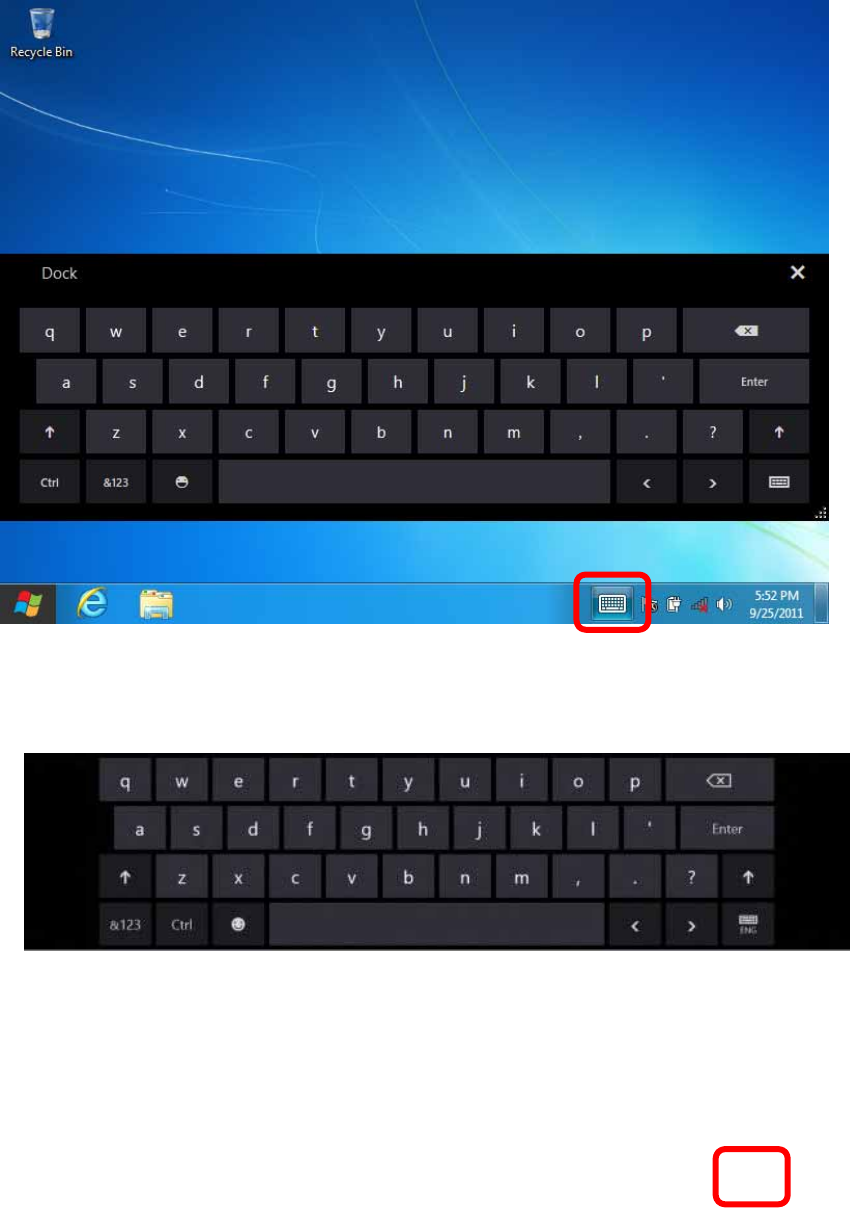
26
3.1.4 Using the On-Screen Keyboard
1. Click on icon in the taskbar to bring up the on-screen keyboard.
2.Use your finger or stylus pen to tap and enter letters, numbers and symbols as you
would with a regular keyboard. To type capital letters tap the lock icon on the
on-screen keyboard.
1. To use handwriting, tap bottom right button of On-Screen
Keyboard.
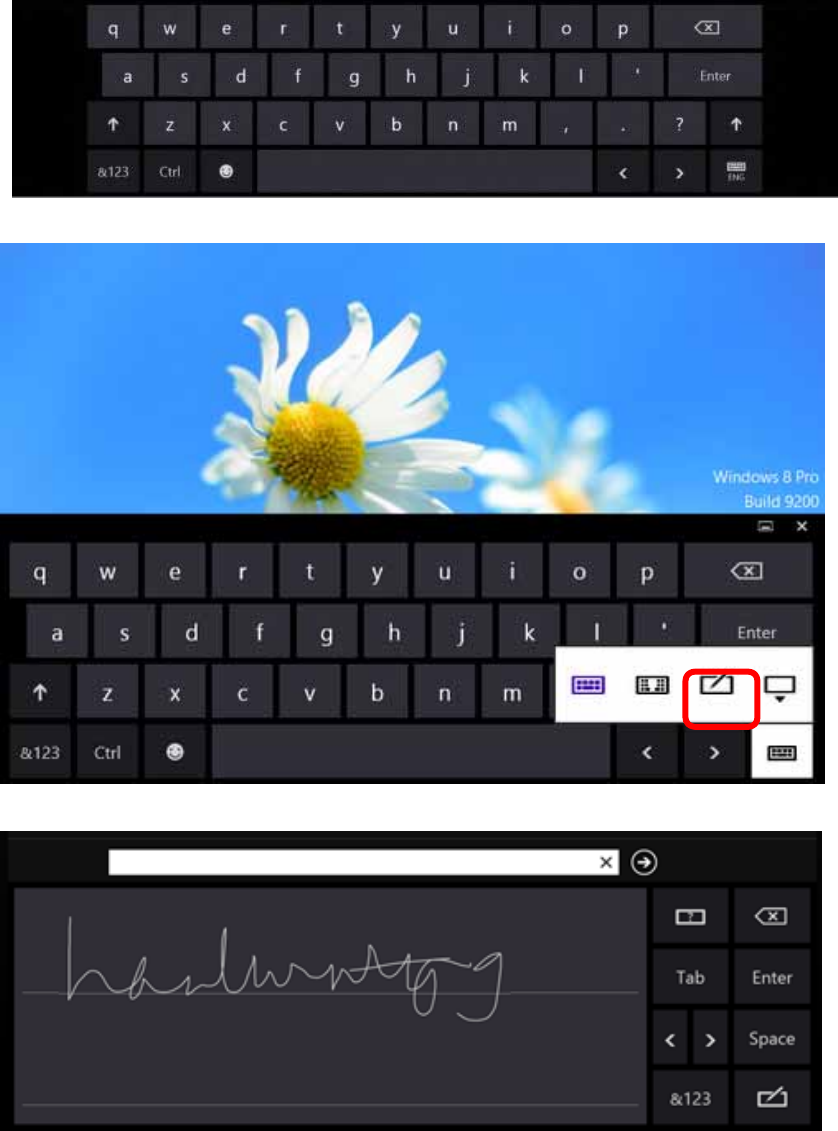
27
2. Select the handwriting icon.
3. Use your finger and stylus pen to write on screen.
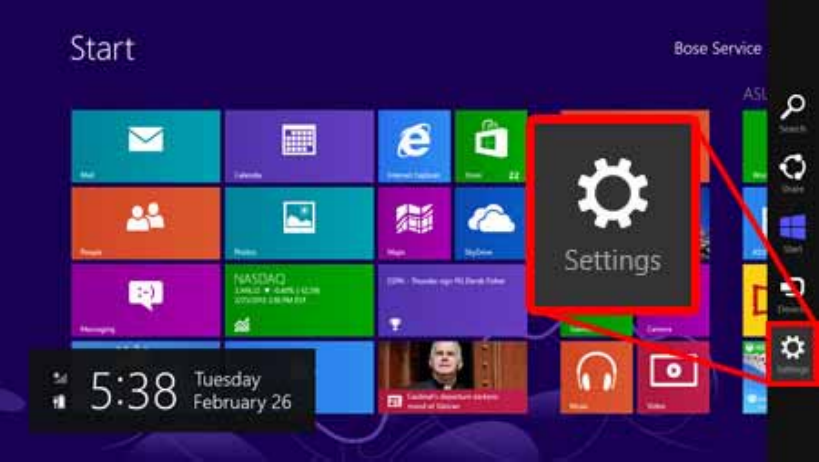
28
3.1.5 Adjusting Screen Brightness
1. Tap the Settings icon on the right.
2.Tap Screen icon to access the brightness control.
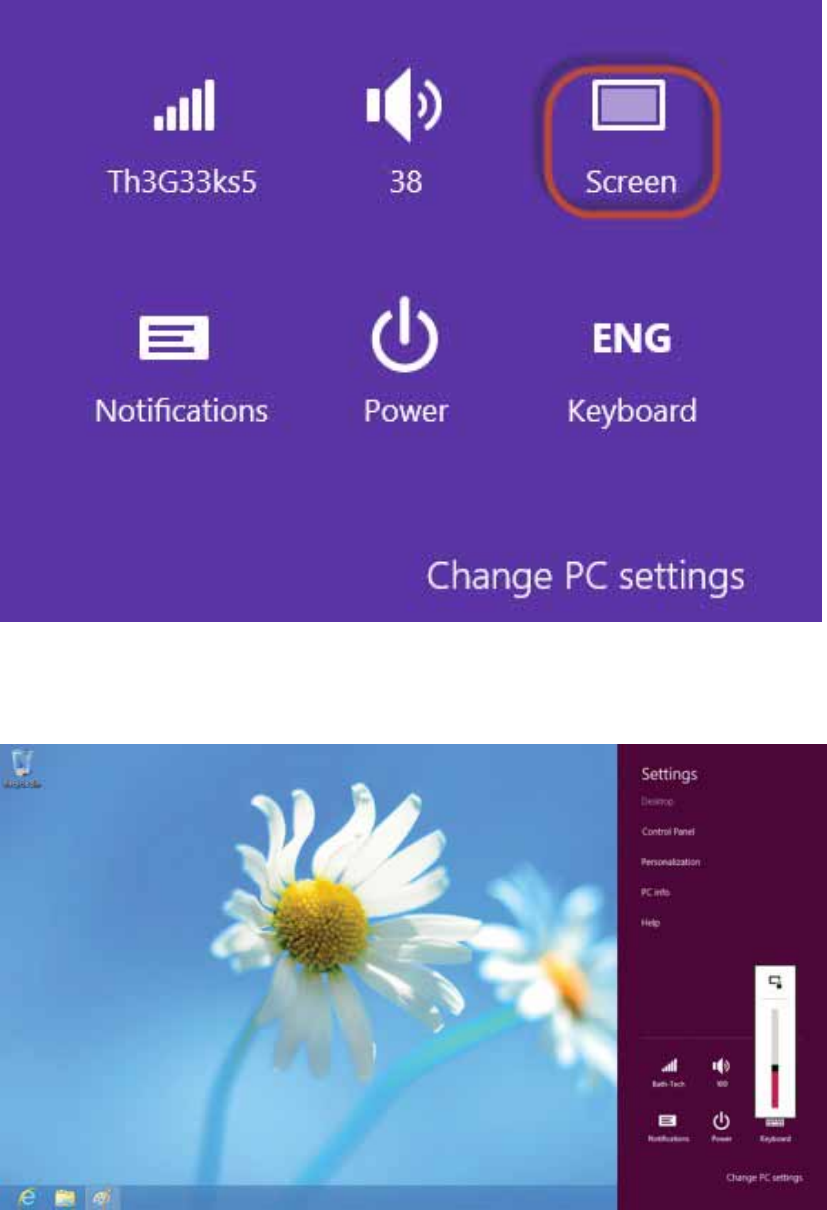
29
3. To move the brightness control bar up / down to increase / decrease brightness.
3.1.6 Adjusting the Volume
1. Tap the Settings icon on the right.
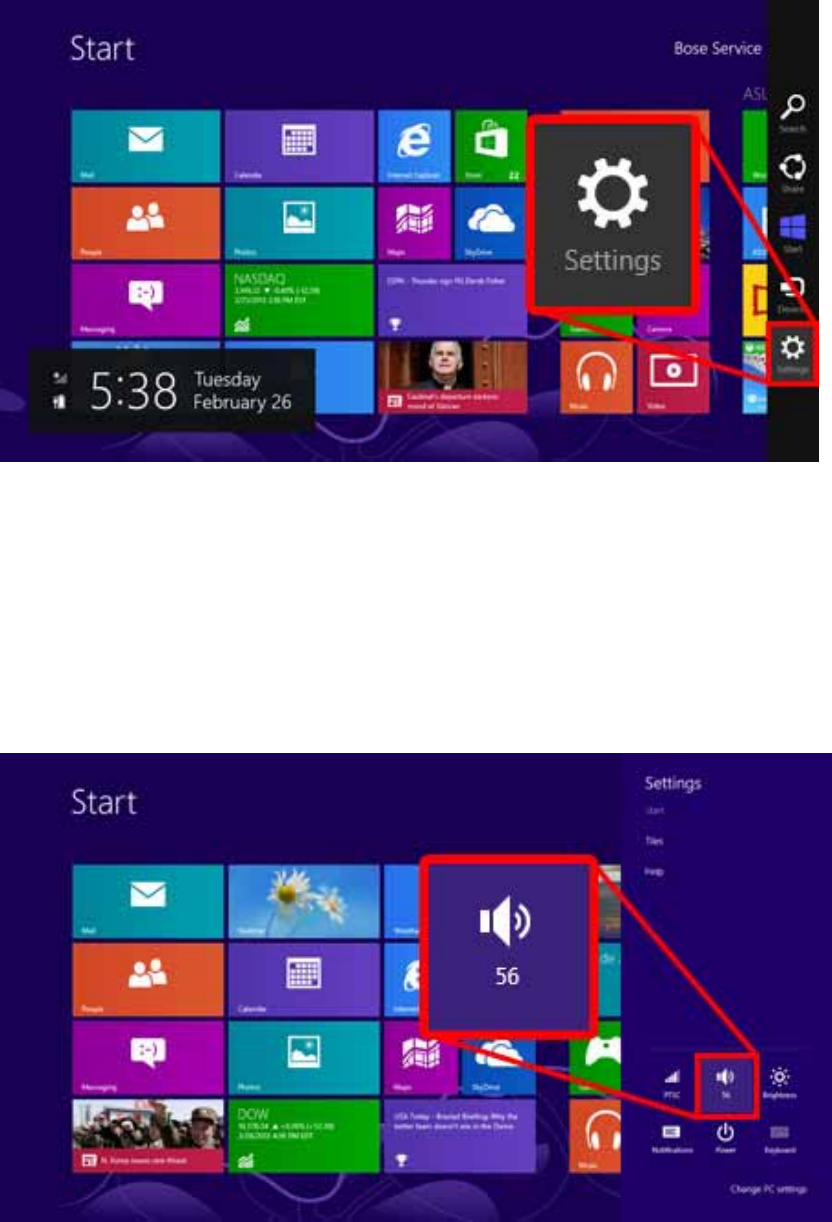
30
2.Tap the Volume icon on the system tray.
1. Move the slide to adjust volume.
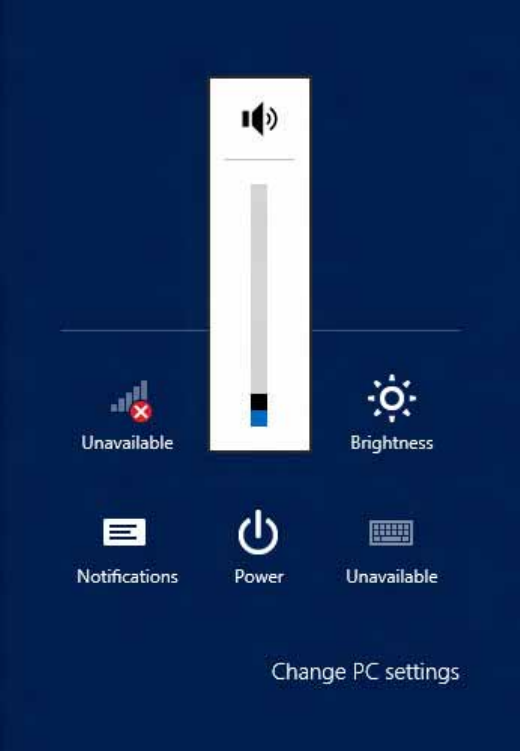
31
2. Tap icon to mute.
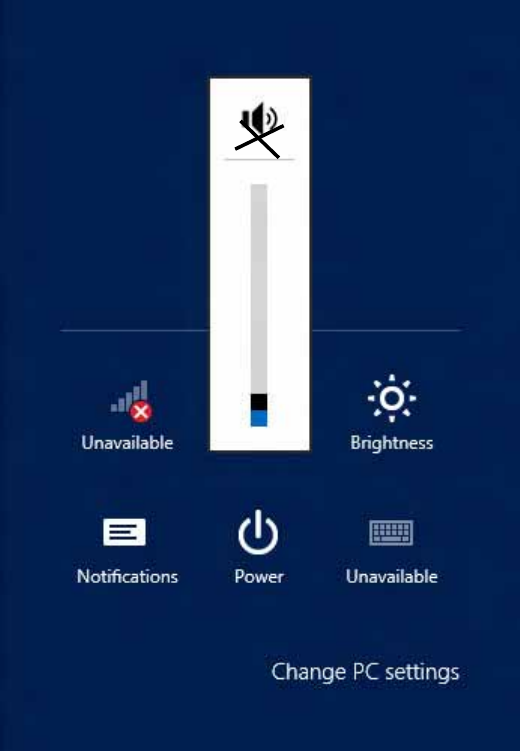
32
33
Chapter 4 Wireless Connections
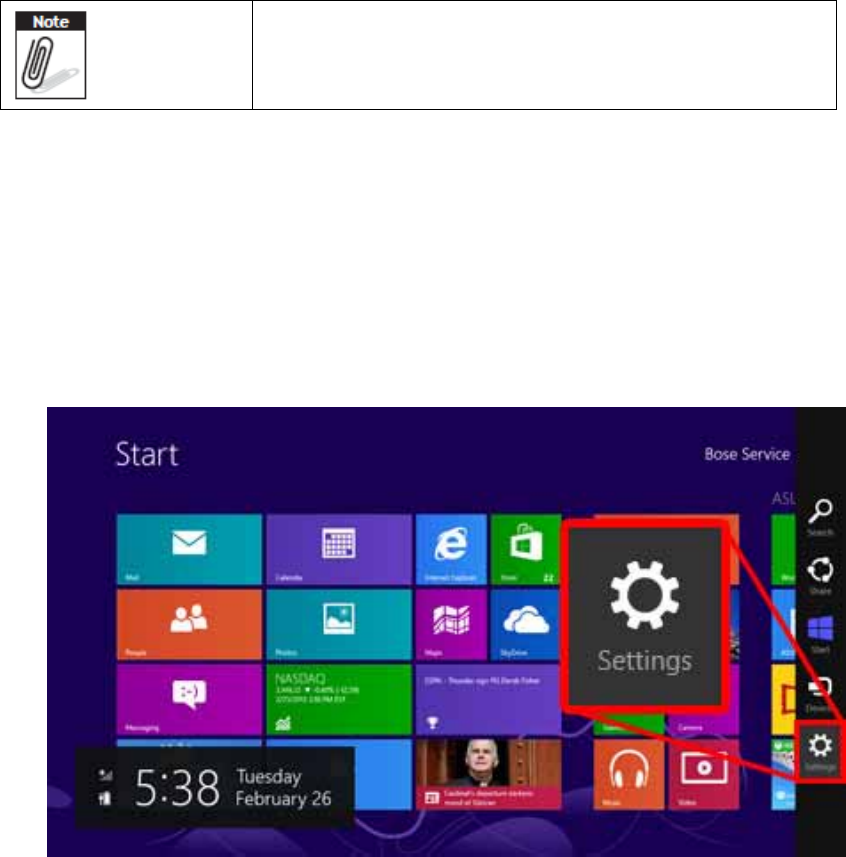
34
4.1 Wi-Fi Connection
Wi-Fi access requires a separate purchase of a service
contract with a wireless service provider. Contact a
wireless service provider for more information.
The MIT-W101-A comes pre-loaded with WLAN module; you can send and receive
signals to a Wi-Fi network then synchronize files.
A wireless network can be added either when the network is detected or by
manually entering settings information. Before doing these steps, determine if
authentication information is needed.
1. Tap the Settings icon on the right.
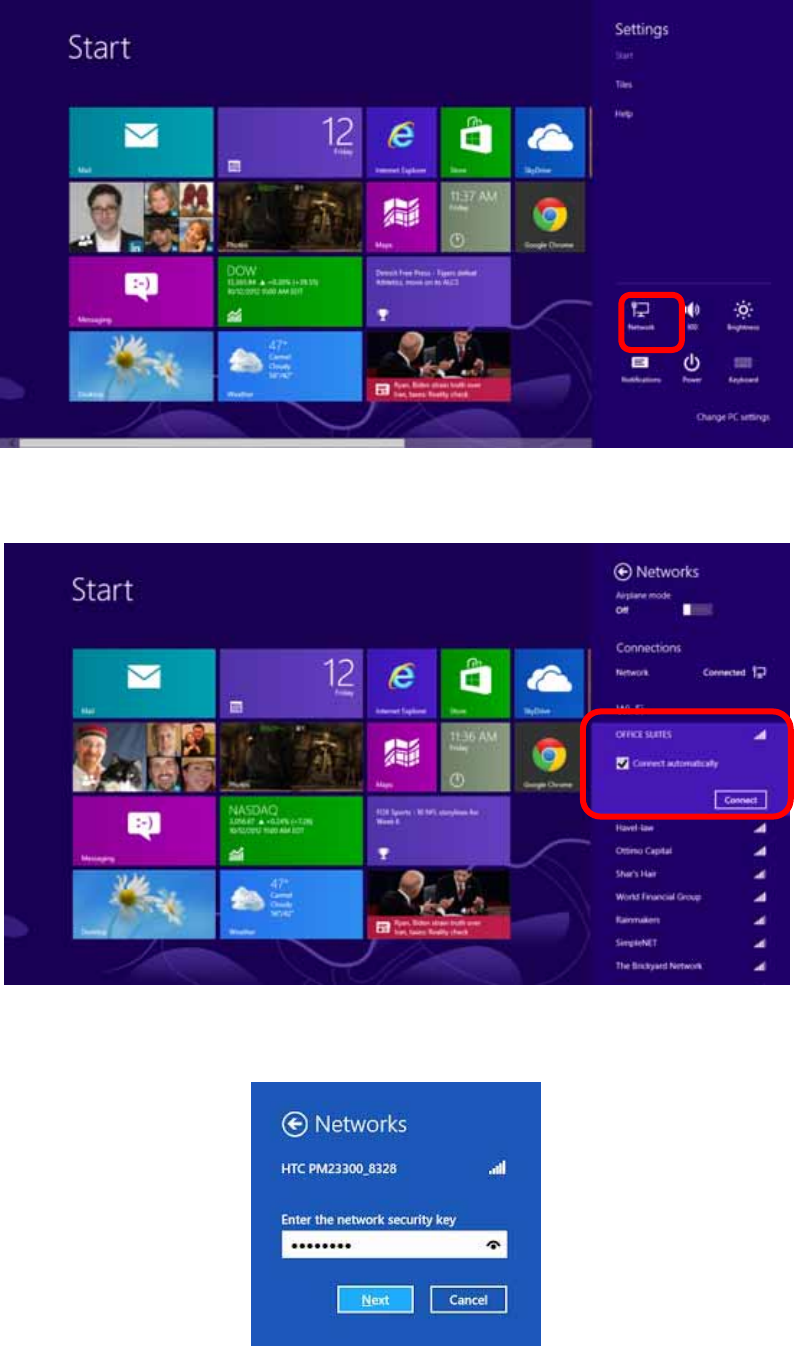
35
2. Click the wireless connection icon in the notification area.
3. Select one of the wireless connections and click Connect.
4. You are prompted to enter a Security key for secure access. Contact the network
administrator for this key.
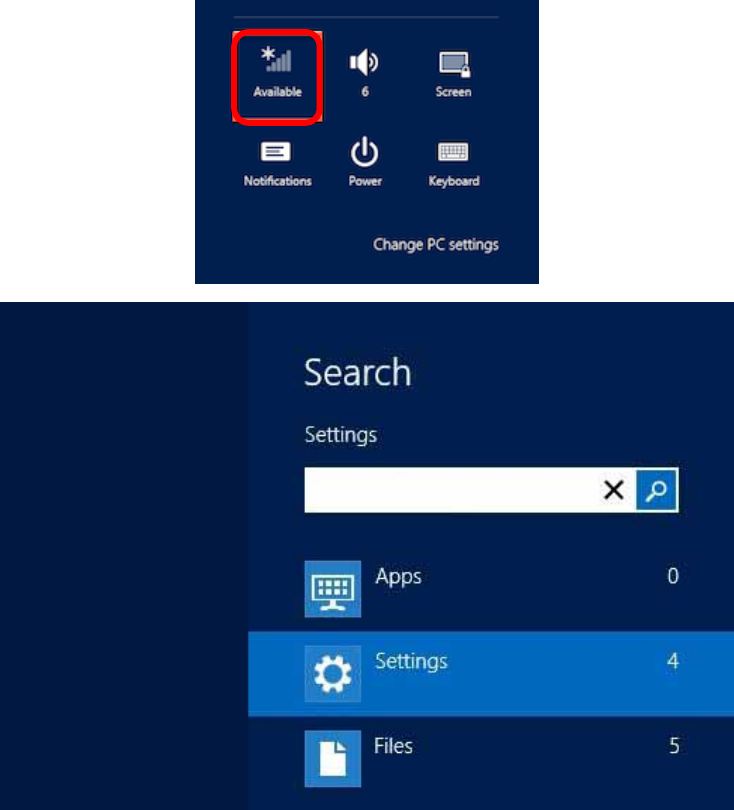
36
5. Enter the required Security key and then tap Next to connect.
6. The wireless connection is negotiated.
The wireless connection icon in the notification area shows a connected status
whenever a wireless connection is present.
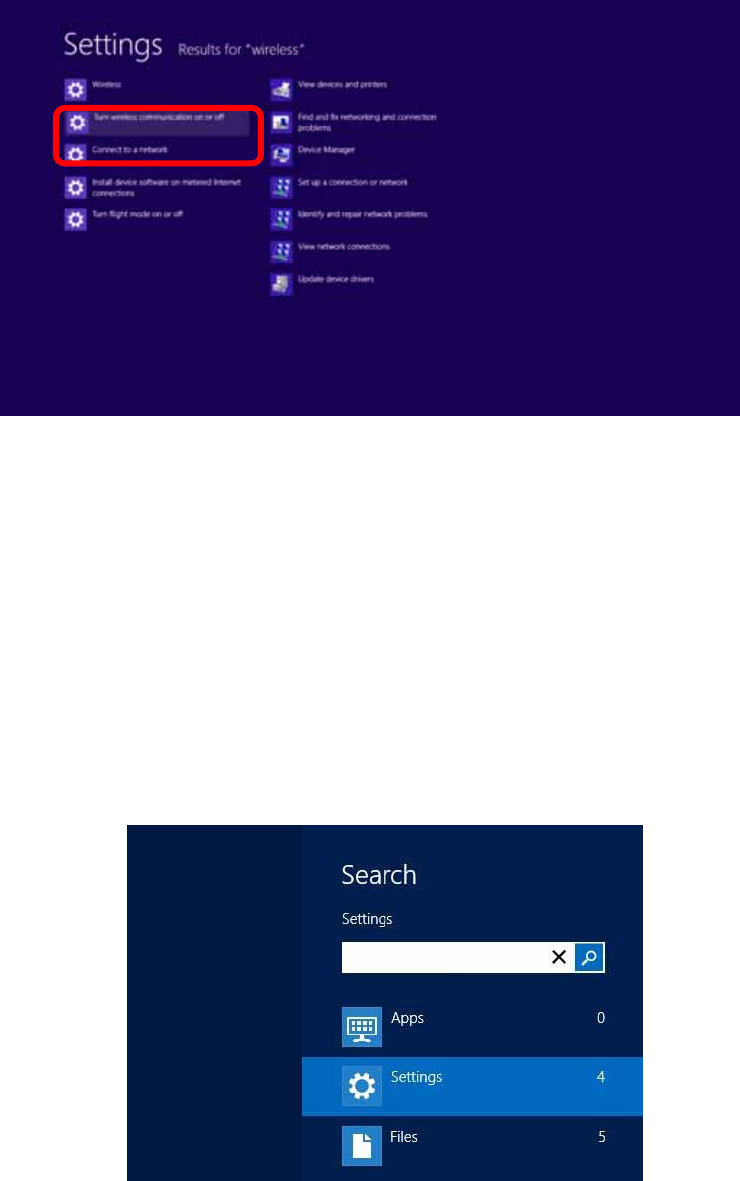
37
Set
airplane mode or turn off wireless devices
4.2 Bluetooth Connections
The MIT-W101-A comes with built-in Bluetooth functionality that allows you to
connect and communicate with other Bluetooth-enabled devices.
4.2.1 Setting Up Bluetooth
Follow these instructions to set up a Bluetooth connection.
1. Type Bluetooth in Search
2. In notification area, tap Add Bluetooth device.
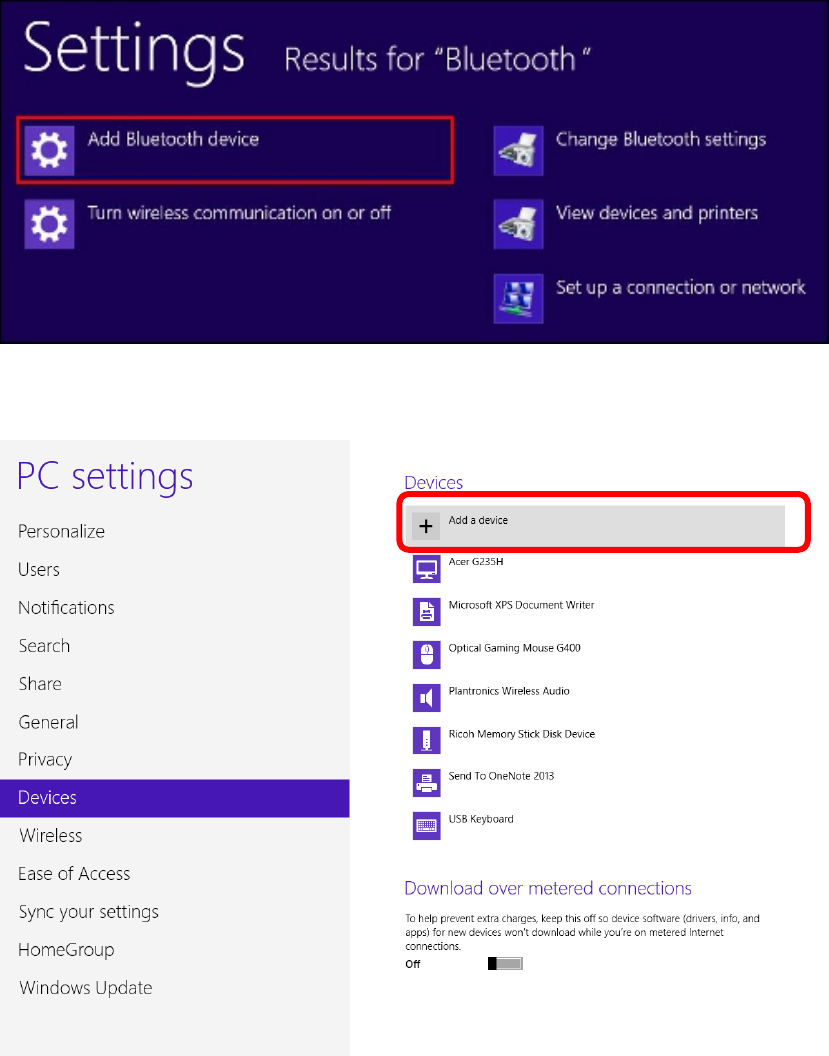
38
3. Add more Bluetooth device by clicking on Add a device.
4. Select Yes for comparing both MIT-W101-A and the Bluetooth device after passkey
is confirmed.
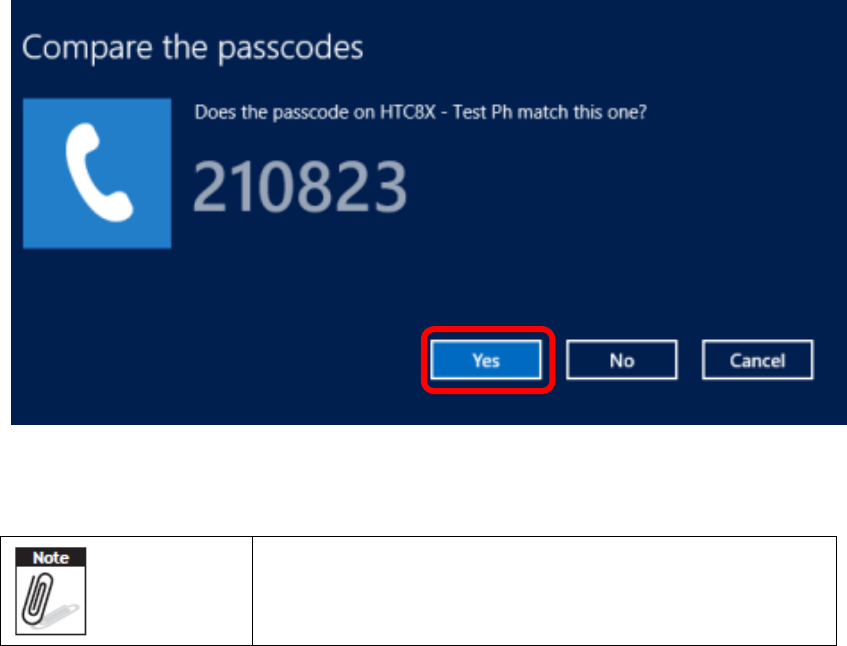
39
5. The Bluetooth device is successfully added into MIT-W101-A when the process is
complete.
It is recommended that you use a passkey to prevent
unauthorized access to your MIT-W101-A.
40
Chapter 5 Advance Setting
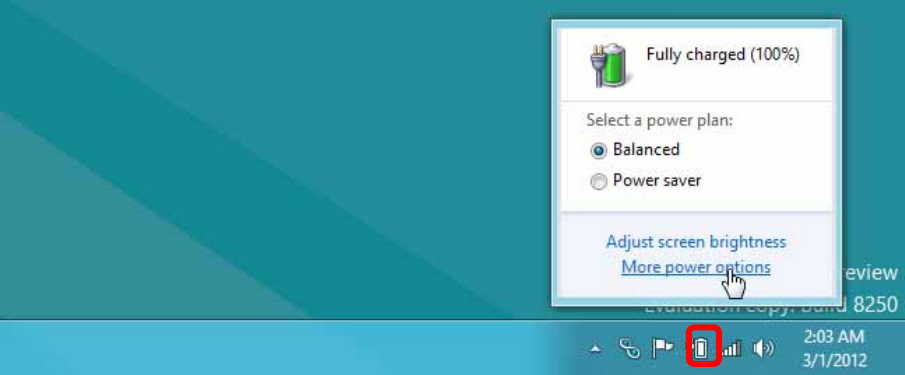
41
5.1 Checking Battery Status
As it is likely you will be using your MIT-W101-A when out and about, it is important
that you monitor the battery status regularly, to ensure you do not run out of power
at a critical moment.
1. Tap on the Power icon on the system tray to view detailed information and the
battery screen appears.
Balanced – Automatically balanced performance with energy consumption.
Power saver – Saves energy by reducing MIT-W101-A’s performance.
5.2 Maintenance
5.2.1 Maintaining the Battery
• Do not expose heat or attempt to disassemble the battery, and do not place the
battery in water or in a fire.
• Do not subject the battery to strong impact, such as a blow from a hammer, or
stepping on or dropping it.
• Do not puncture or disassemble the battery.
• Do not attempt to open or service the battery.
• Replace only with batteries designed specifically for this product.
• Keep the battery out of reach of children.
• Dispose of used batteries according to local regulations.
42
5.2.2 Maintaining the LCD Display
• Do not scratch the surface of the screen with any hard objects.
• Do not spray liquid directly on the screen or allow excess liquid to drip down inside
the device.
• Do not place anything, such as food and drink, on the screen at any time to prevent
damage to the screen.
• Clean the LCD display only with a soft cloth dampened with 60% above isopropyl
alcohol or 60% above ethyl alcohol.
5.2.3 Cleaning the MIT-W101-A
1. Turn off the MIT-W101-A and unplug the power cord.
2. Wipe the screen and exterior with a soft, damp cloth moistened only with water.
Do not use liquid or aerosol cleaners on the screen, as these will discolor the finish
and damage the screen.
5.3 Trouble Shooting
When System behaves abnormally, such as
1. Failure to power on.
2. Failure to power off.
3. Power on LED off but DC power plug in.
4. Any other LEDs ON but system cannot work.
Contact your distributer, sales representative, or Advantech’s customer service
center for technical support if you need additional assistance. Please have the
following information ready before you call:
Product name and serial number.
Descriptions of your peripheral attachments.
Descriptions of your software (operating system, version, application software,
etc.)
A complete description of the problem.
The exact wording of any error messages.
Symptoms, photo or video if available.

43
Guidance and manufacturer’s declaration – electromagnetic emissions
The model MIT-W101 SERIES is intended for use in the electromagnetic environment specified below. The customer
or the user of the model MIT-W101 SERIES should assure that it is used in such an environment.
Emissions test Compliance Electromagnetic environment –
guidance
RF emissions
CISPR 11
The model MIT-W101 SERIES uses RF
energy only for its internal function.
Therefore, its RF emissions are very low
and are not likely to cause any
interference in nearby electronic
equipment.
RF emissions
CISPR 11
The model MIT-W101 SERIES is suitable
for use in all establishments, including
domestic establishments and those
directly connected to the public
low-voltage power supply network that
supplies buildings used for domestic
purposes.
Harmonic emissions
IEC 61000-3-2
Voltage fluctuations/
flicker emissions
IEC 61000-3-3
Recommended separation distances between
portable and mobile RF communications equipment and the model MIT-W101 Series
The model MIT-W101 series is intended for use in an electromagnetic environment in which radiated RF
disturbances are controlled. The customer or the user of the model MIT-W101 series can help prevent
electromagnetic interference by maintaining a minimum distance between portable and mobile RF communications
equipment (transmitters) and the model MIT-W101 series as recommended below, according to the maximum output
power of the communications equipment.
Rated maximum output power
of transmitter
W
Separation distance according to frequency of transmitter
m
150 kHz to 80 MHz
d = 1,2
80 MHz to 800 MHz
d = 1,2
800 MHz to 2,5 GHz
d = 2,3
0,01 0,12 0,12 0,23
0,1 0,38 0,38 0,73
1 1,2 1,2 2,3
10 3,8 3,8 7,3
100 12 12 23

44
For transmitters rated at a maximum output power not listed above, the recommended separation distance d in
metres (m) can be estimated using the equation applicable to the frequency of the transmitter, where P is the
maximum output power rating of the transmitter in watts (W) according to the transmitter manufacturer.
NOTE 1 At 80 MHz and 800 MHz, the separation distance for the higher frequency range applies.
NOTE 2 These guidelines may not apply in all situations. Electromagnetic propagation is affected by absorption and
reflection from structures, objects and people.
Guidance and manufacturer’s declaration – electromagnetic immunity
The model MIT-W101 SERIES is intended for use in the electromagnetic environment specified below. The customer
or the user of the model MIT-W101 SERIES should assure that it is used in such an environment.
Immunity test
IEC
60601
test
level
Compliance
level
Electromagnetic environment – guidance
Conducted RF
IEC 61000-4-6
Radiated RF
IEC 61000-4-3
3
Vrms
150
kHz
to 80
MHz
3 V/m
80
MHz
to 2,5
GHz
Vrms
V/m
Portable and mobile RF communications equipment
should be used no closer to any part of the model
MIT-W101 SERIES, including cables, than the
recommended separation distance calculated from the
equation applicable to the frequency of the transmitter.
Recommended separation distance
d = 1,2
d = 1,2 80 MHz to 800 MHz
d = 2,3 800 MHz to 2,5 GHz
where P is the maximum output power rating of the
transmitter in watts (W) according to the transmitter
manufacturer and d is the recommended separation
distance in metres (m).
Field strengths from fixed RF transmitters, as determined
by an electromagnetic site survey, a should be less than
the compliance level in each frequency range. b
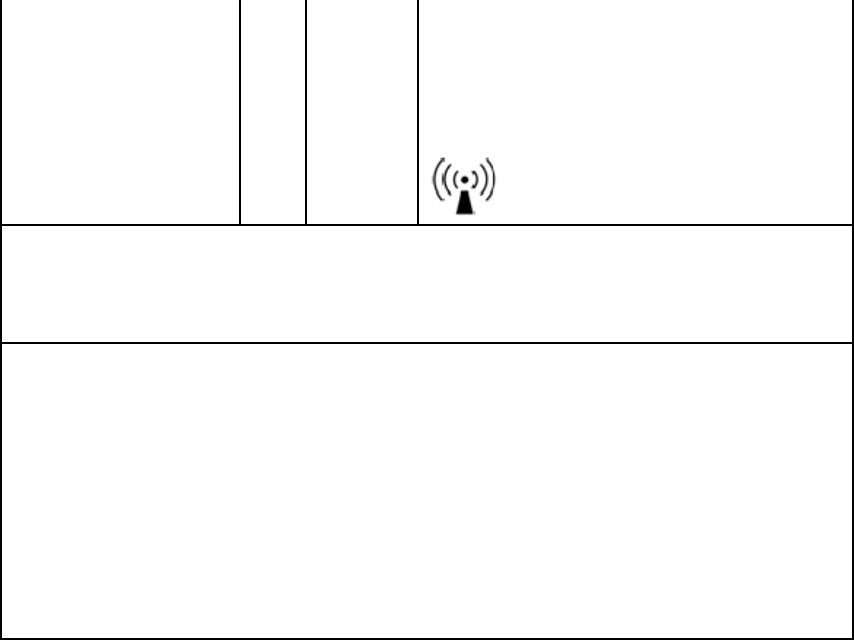
45
Interference may occur in the vicinity of equipment marked
with the following symbol:
NOTE 1 At 80 MHz and 800 MHz, the higher frequency range applies.
NOTE 2 These guidelines may not apply in all situations. Electromagnetic propagation is affected by absorption
and reflection from structures, objects and people.
a Field strengths from fixed transmitters, such as base stations for radio (cellular/cordless) telephones and land
mobile radios, amateur radio, AM and FM radio broadcast and TV broadcast cannot be predicted theoretically with
accuracy. To assess the electromagnetic environment due to fixed RF transmitters, an electromagnetic site survey
should be considered. If the measured field strength in the location in which the model MIT-W101 SERIES is used
exceeds the applicable RF compliance level above, the model MIT-W101 SERIES should be observed to verify
normal operation. If abnormal performance is observed, additional measures may be necessary, such as
reorienting or relocating the model MIT-W101 SERIES.
b Over the frequency range 150 kHz to 80 MHz, field strengths should be less than V/m.
46
Chapter 6 Dashboard Installation & Hotkey setting
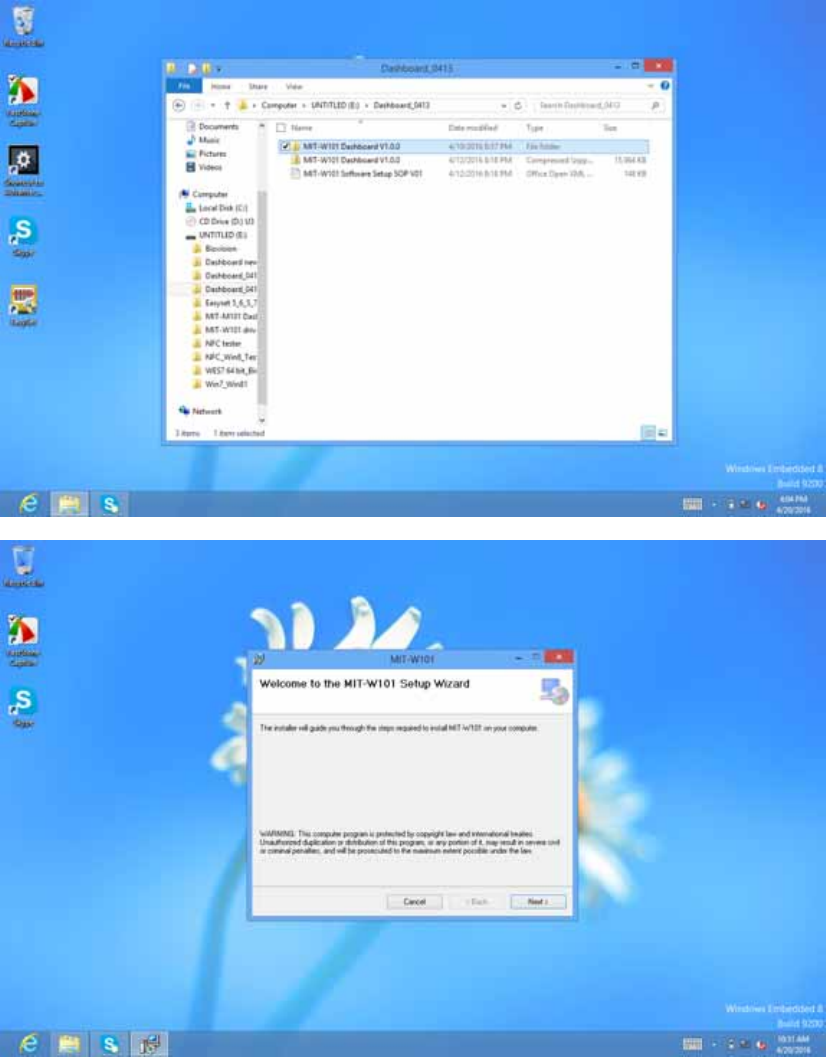
47
6.1 Installation
6.1.1 Extract file “MIT-W101-Dashboard v1.0.0
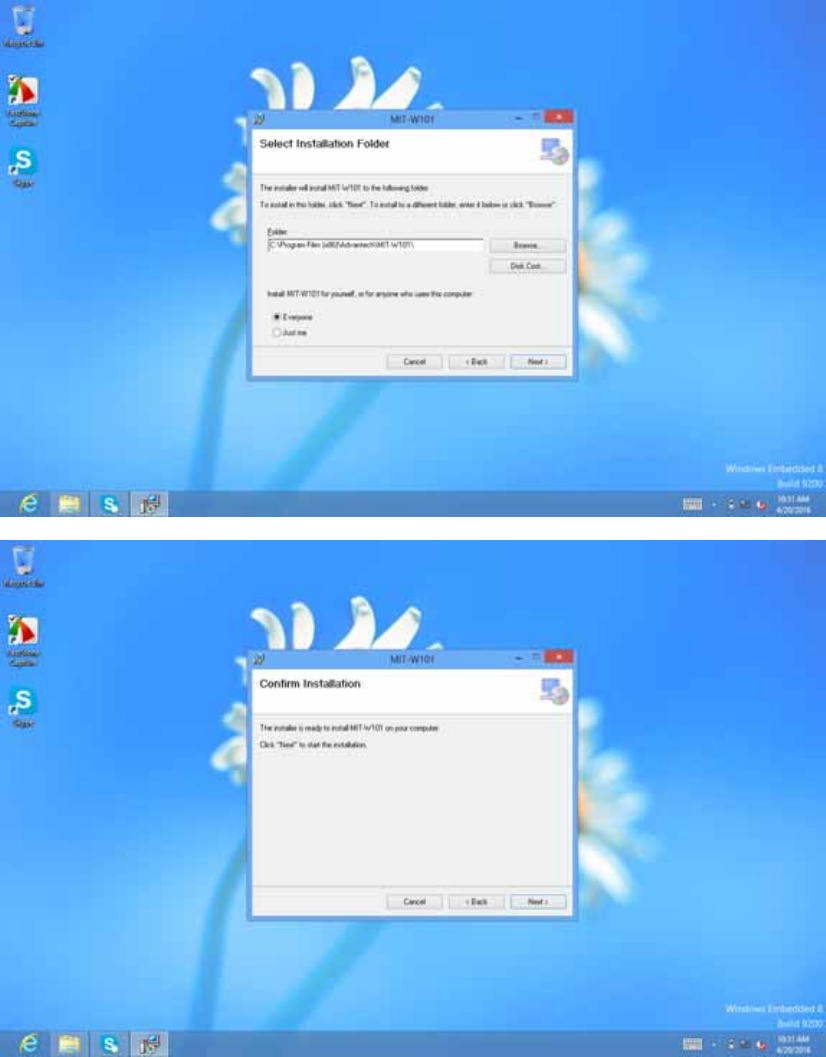
48
6.1.2 Follow the procedure to install the dashboard
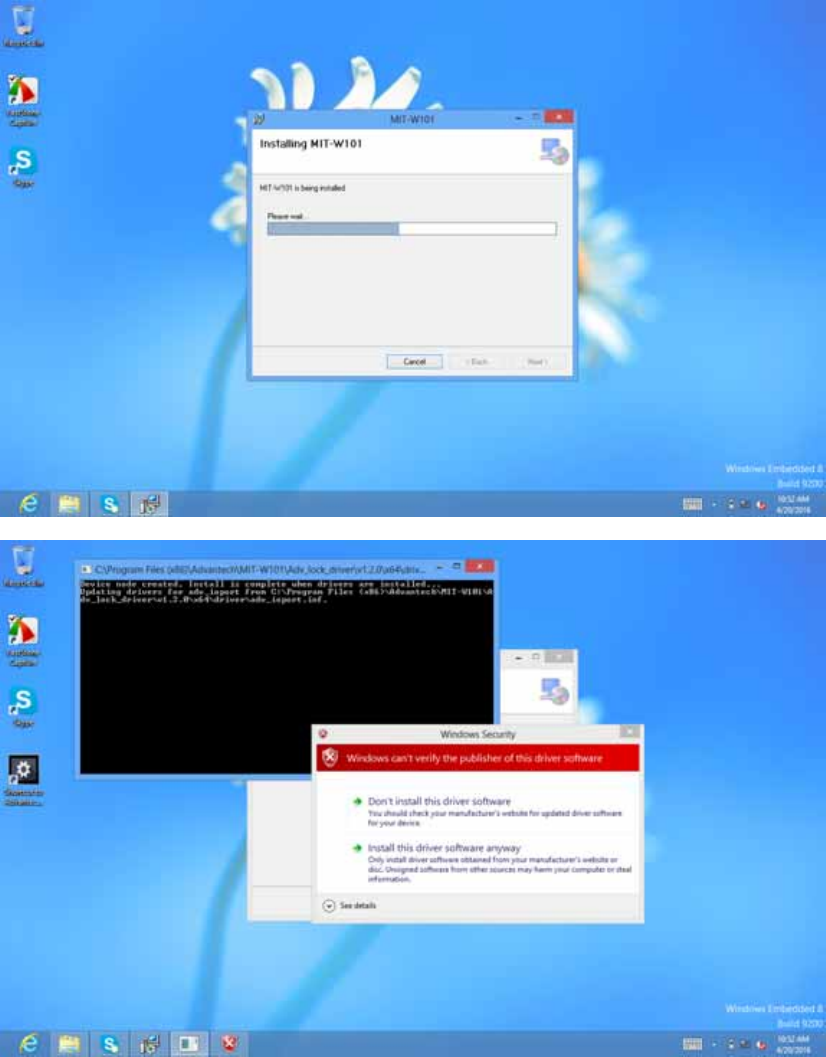
49
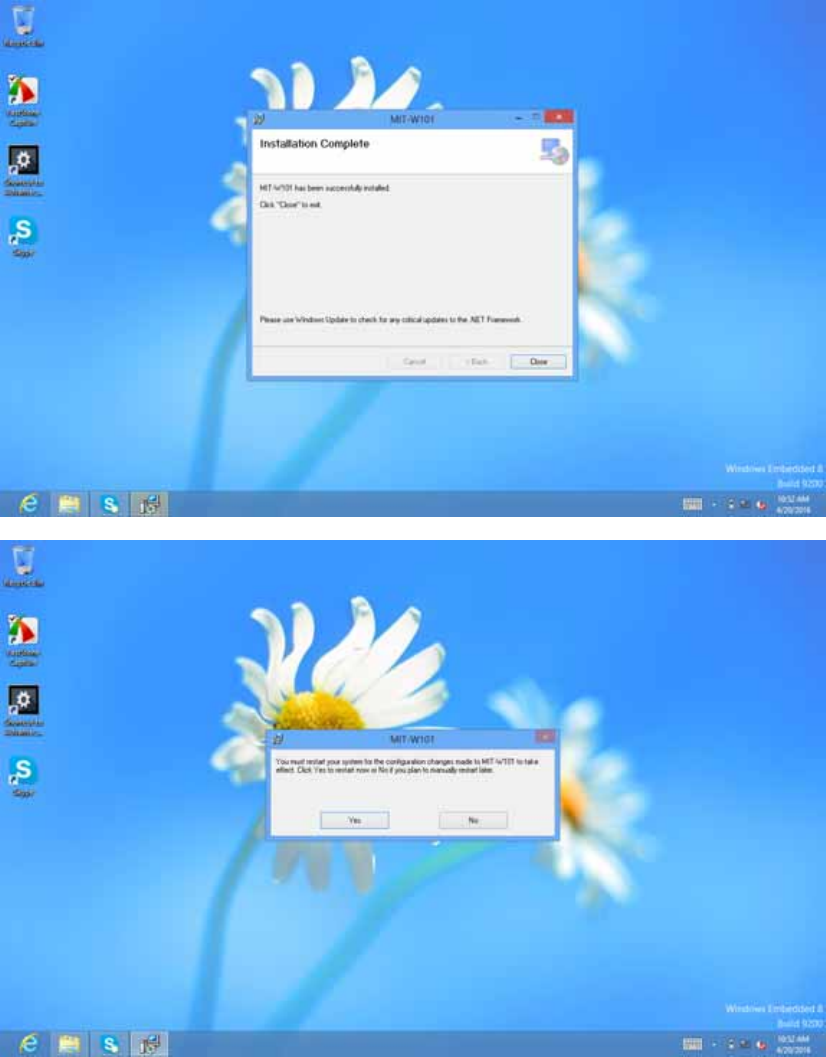
50
6.1.3 Install completed and re-start MIT-W101
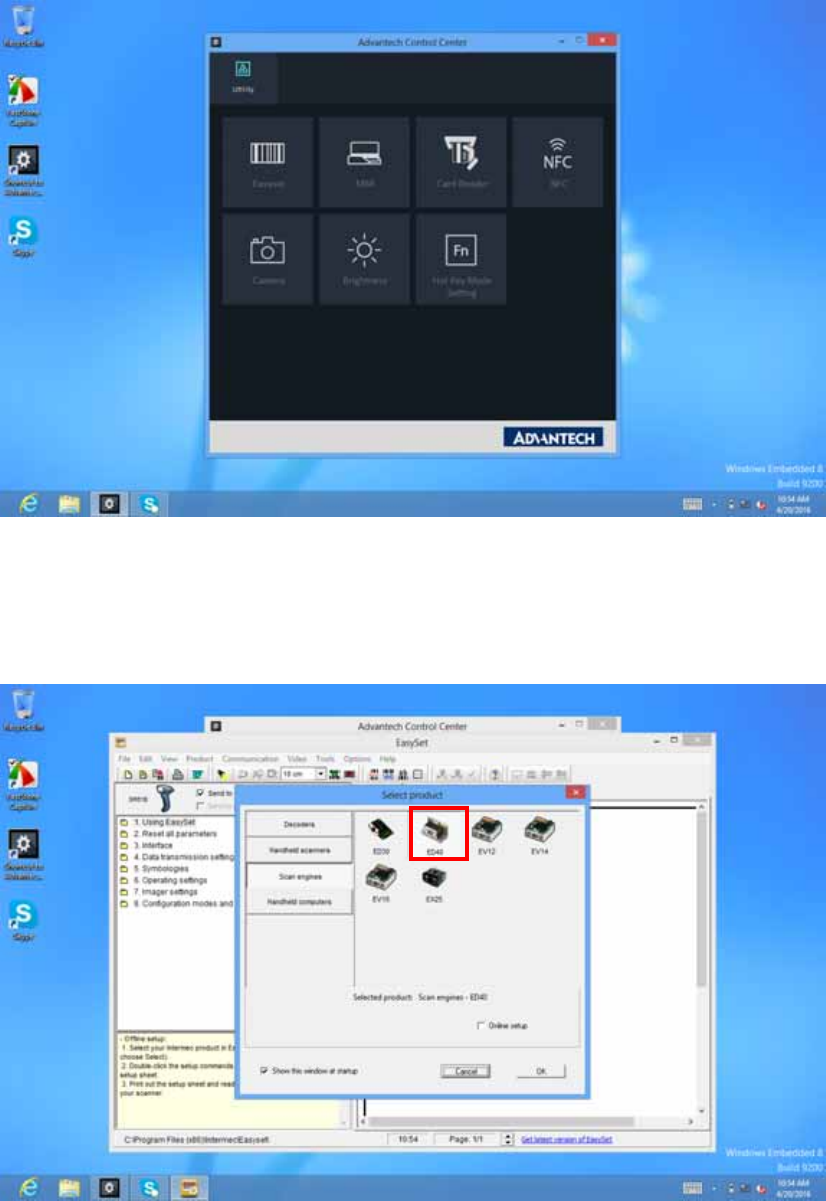
51
6.2 Start to use
6.2.1 Click icon of “Advantech Control Center”
6.2.2 Barcode reader
6.2.2.1 Barcode reader setting
(1)SelectProduct“ED40”,clickok
(2)SelectCommunicationInterface“ED40,HIDKeyboard”
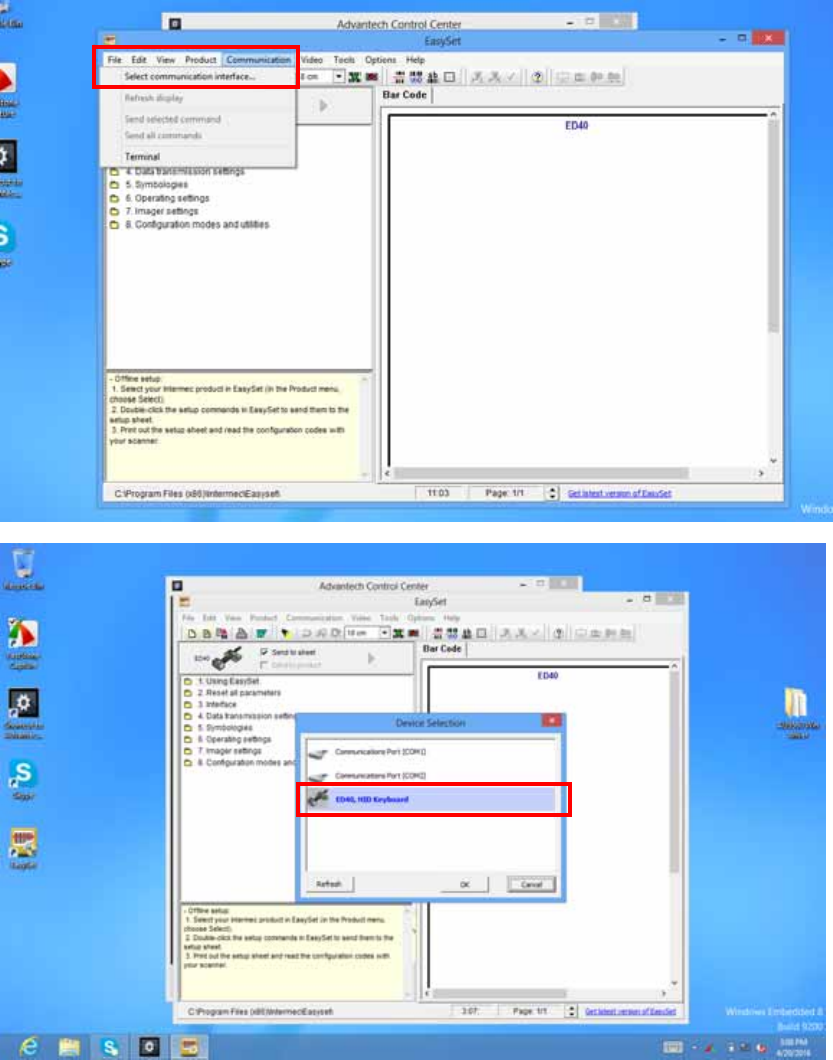
52
(3)SelectTriggerModesLevelMode
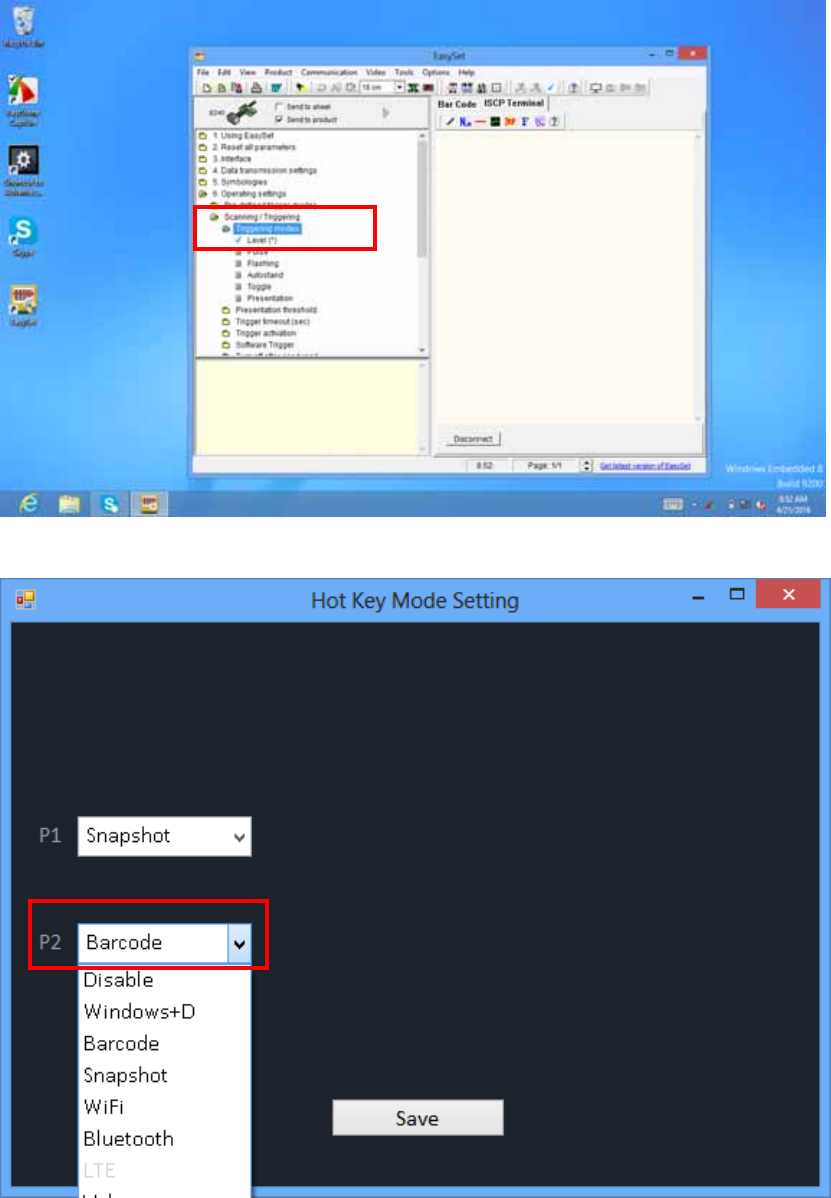
53
(4)SetP2keyasabarcodetriggerKey(P1keyalsocouldbeconfigurable)
(5)Aimthebarcodescannerattheobjectbarcode,pressP2key.Barcodecontents
willshowinthewordornotepadfile.
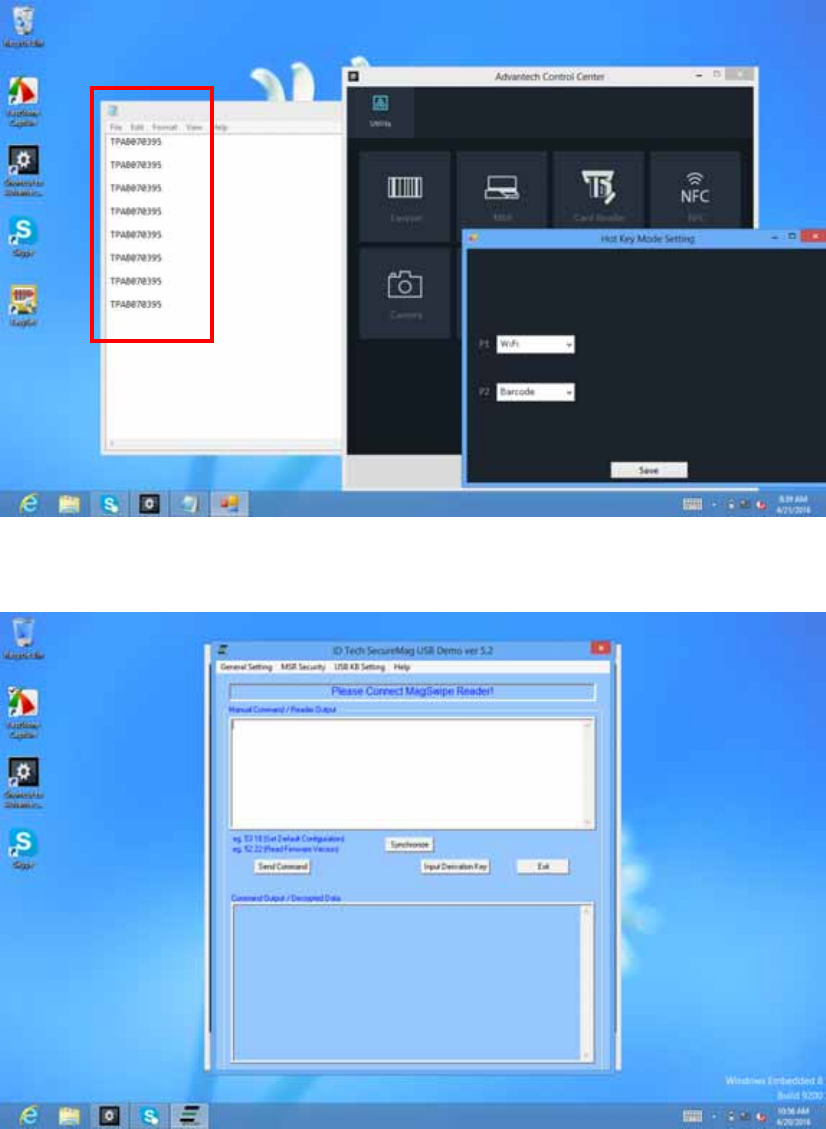
54
6.2.3 MSR (enable with expansion module / MIT-W101-ACCEM000E)
6.2.3.1 Click MSR icon
6.2.3.2 Slip MSR card by Expansion module
MSRcardDatawillbeshowninthetool.
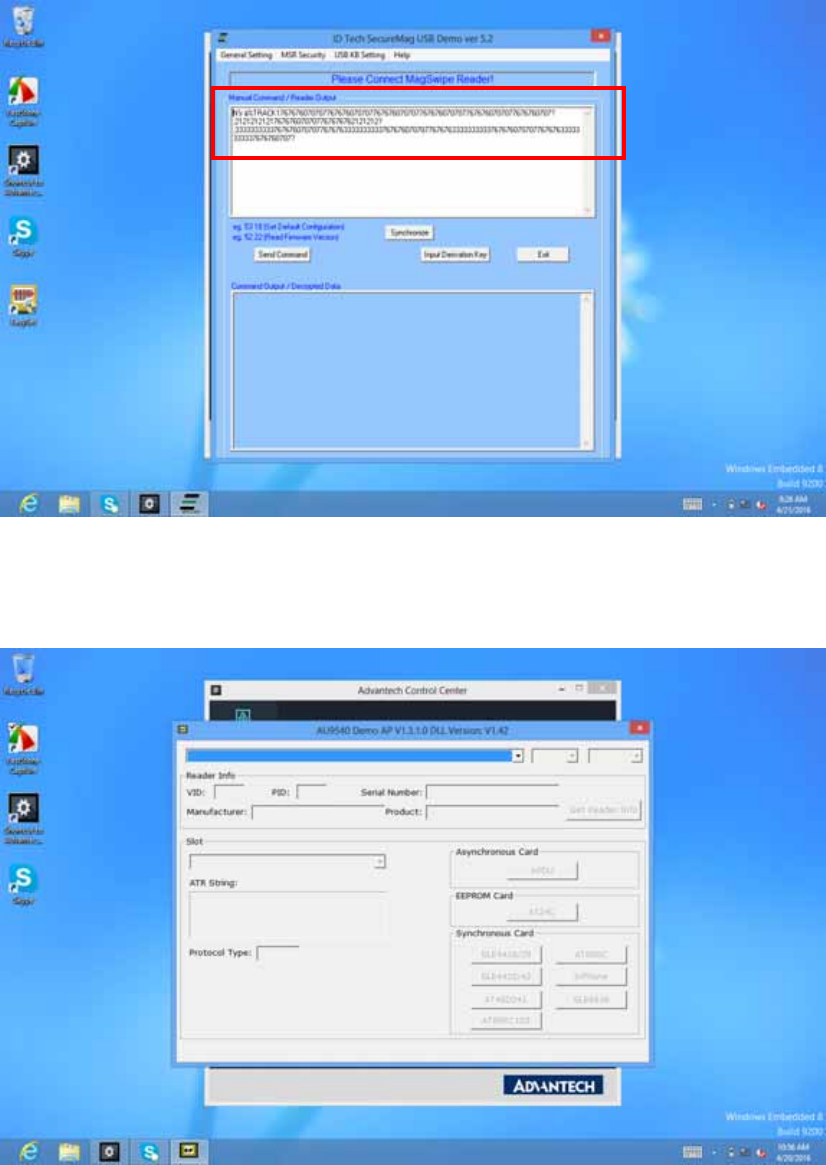
55
6.2.4 Smart Card (enable with Expansion module)
6.2.4.1 Click Smart Card Reader icon
6.2.4.2 Insert Smart Card
SmartCarddatawillshowin“ATRString:“
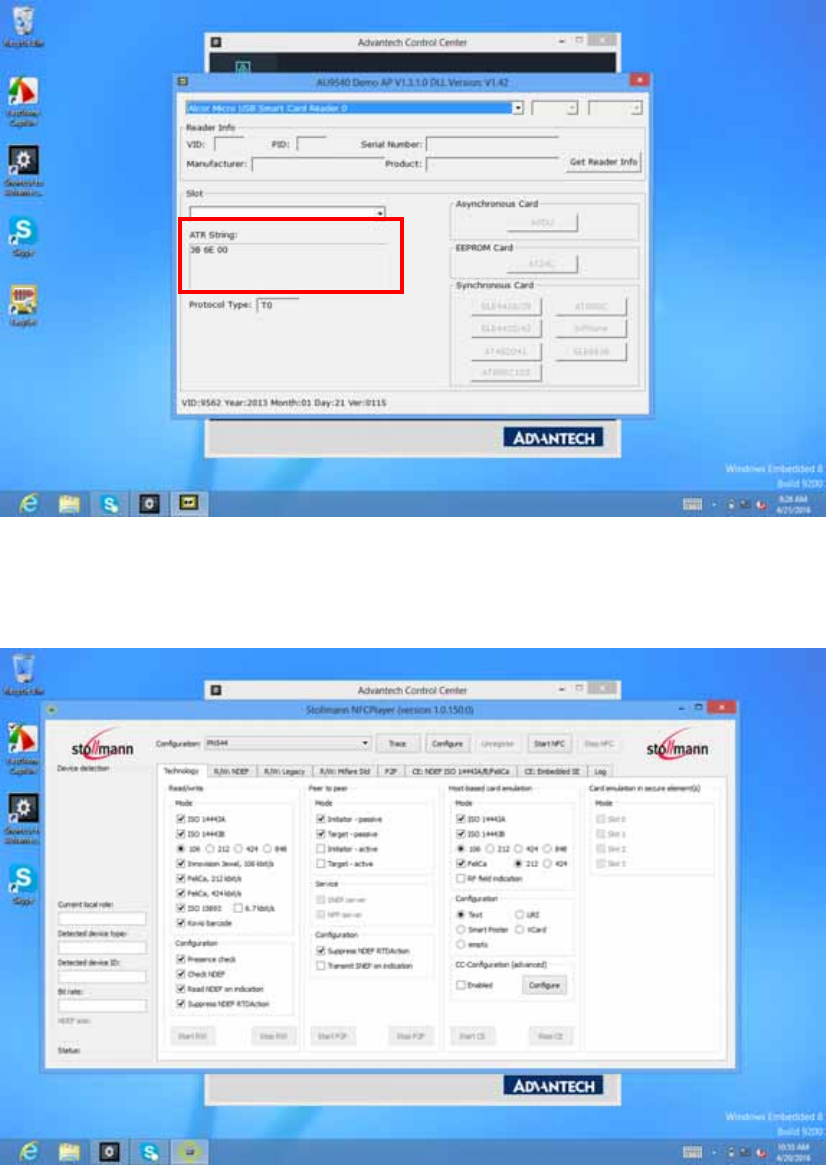
56
6.2.3 NFC
6.2.3.1 Click NFC icon
6.2.3.2 NFC setting
(1)ClickConfigure,selectCOMportandsave.
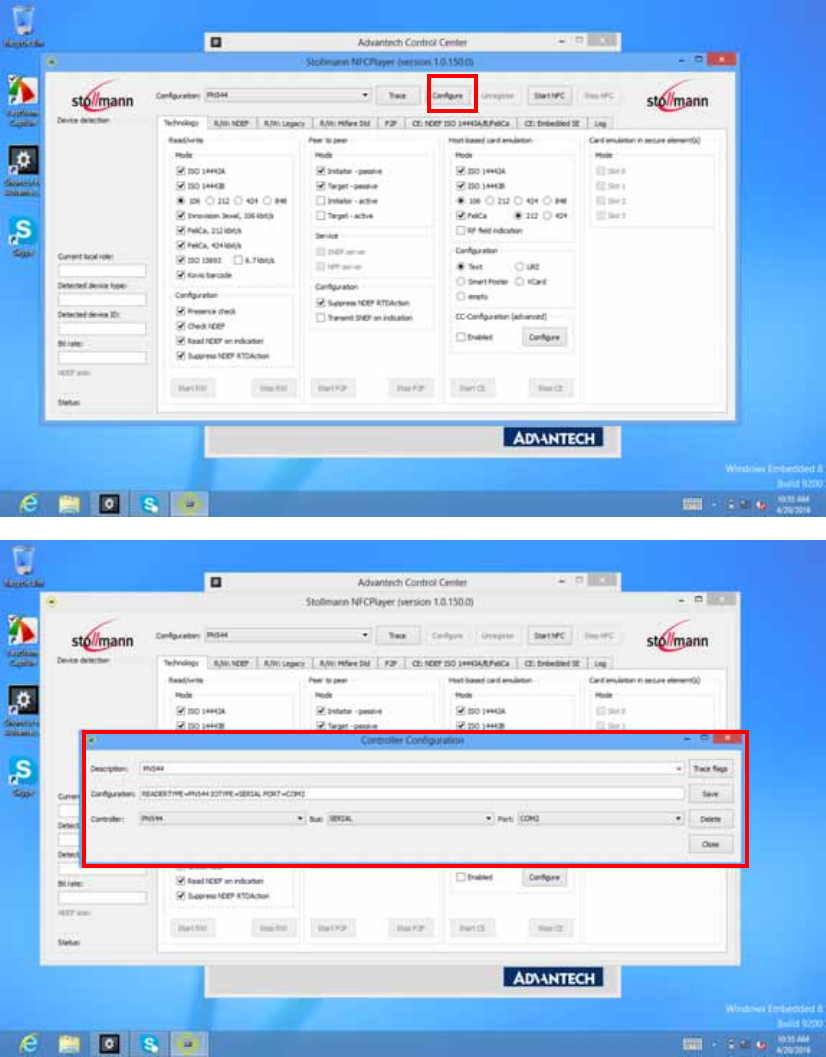
57
(2)Click“StartNFC”and“StartRW”.LeftIconwillturninto“Green”
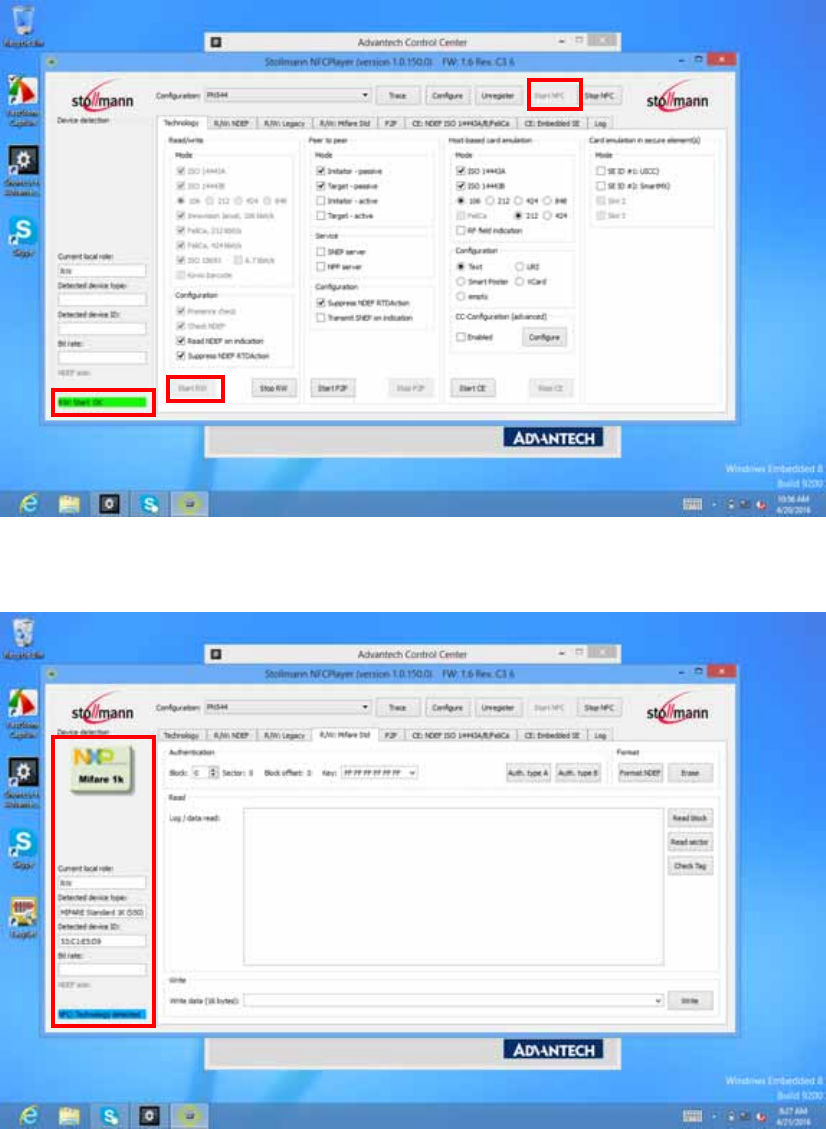
58
6.2.3.3 NFC reading
(1)NFCwasdetected.
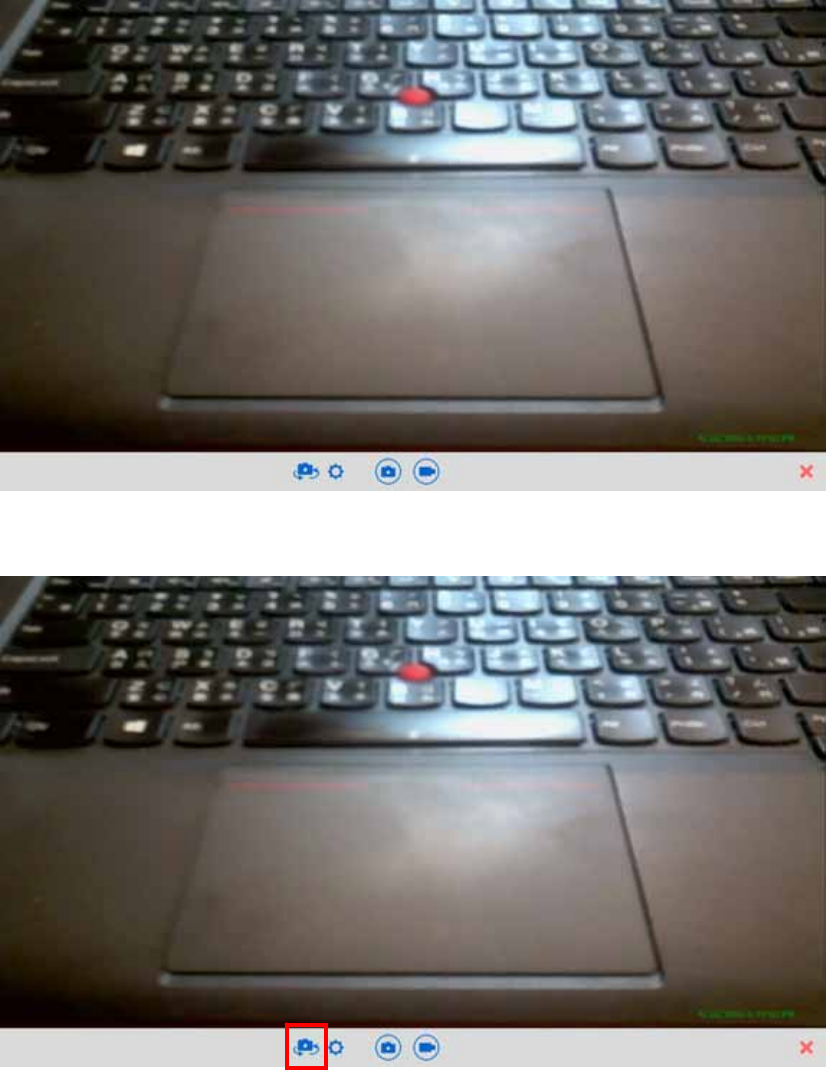
59
6.2.4Camera
6.2.4.1 Click Camera icon (Default Rear Camera)
6.2.4.2 Switch Front / Rear Camera
(Clickcameraicontoswitchcamera)
6.2.4.3 Video Recording
Clickvideoicon
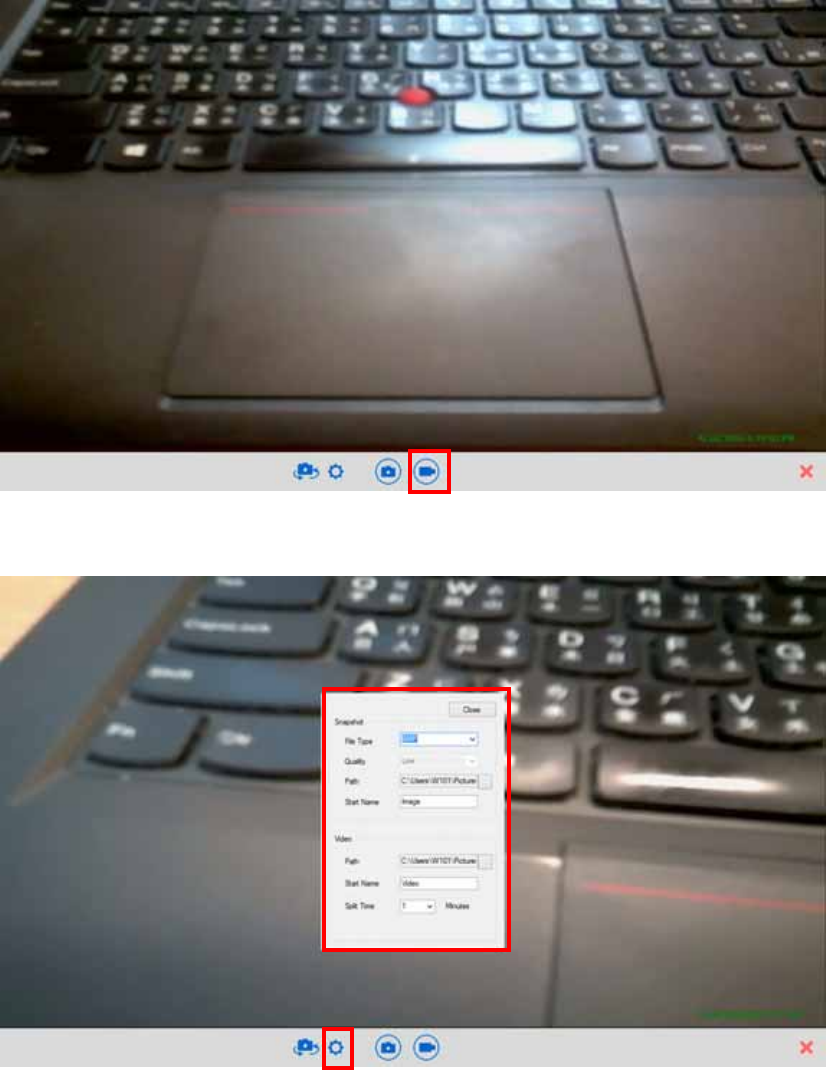
60
6.2.4.4 Camera Setting
Clicksettingicontochangefilenameandpath.
6.2.5 Brightness
ClickBrightnessicontoadjustbrightness

61
6.2.6 Hotkey Setting
ClickHotkeyModeSettingandselectfunction.
E.g.:SetP1keyasWiFiON/OFFkey.
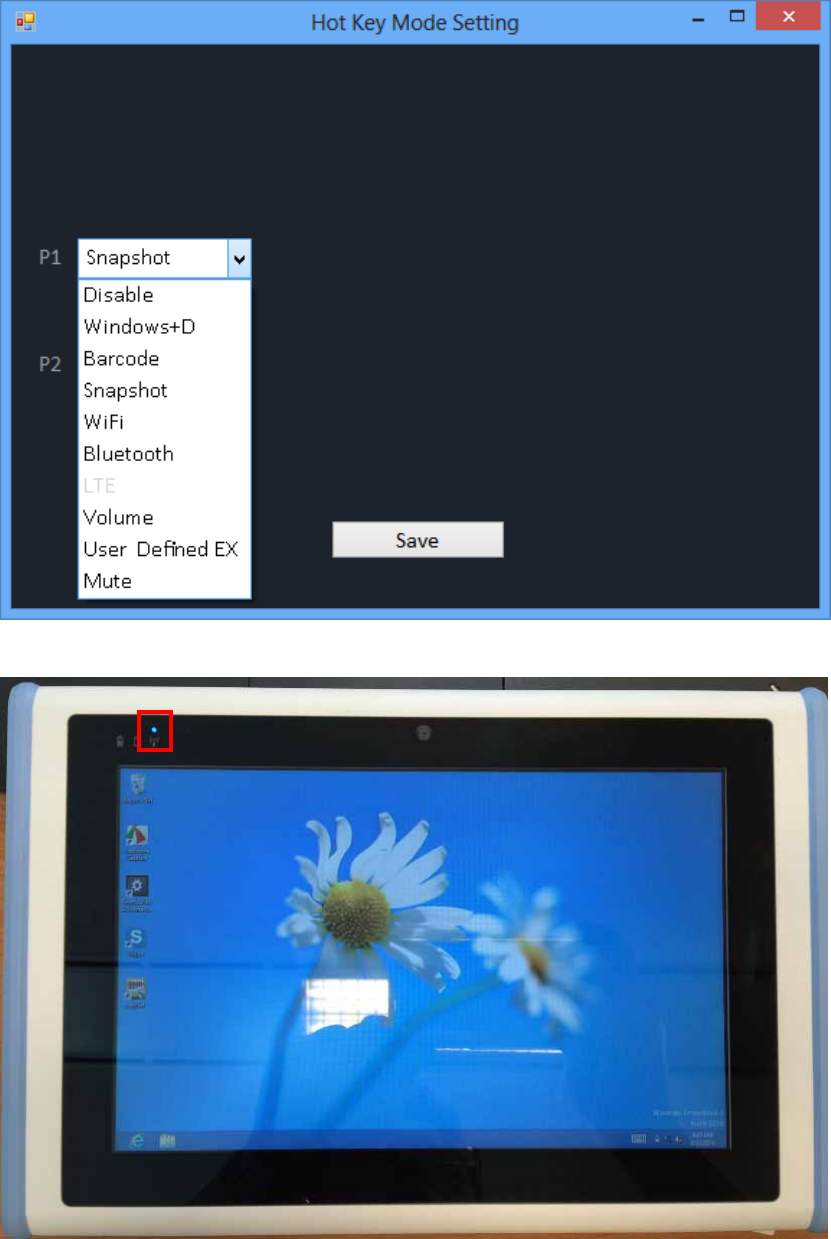
62
WiFiLEDwillturnon/offonceP1keywaspressed.
63
Appendix Specifications

64
A.1 Specifications
Feature Description
Operating System
Microsoft Windows Embedded 8 Standard
Microsoft Windows 7 Professional for Embedded System
(Optional)
Processor Intel® Celeron® Processor N2930
Max. speed Quad Core 1.83GHz
Chipset Intel® Bay Trail-M SoC
Memory One DDR3L 1333MHz SO-DIMM, up to 8GB
Storage One mSATA SSD, up to 128GB
Display 10.1” WXGA TFT LCD
Touch Panel P-CAP Multiple Touch
Application Button
One Power button
Two Function programmable buttons for quick
selection of applications
Communication 802.11a/b/g/n WLAN built-in with integrated antenna
Bluetooth class 2, 4.0 + EDR built-in with integrated antenna
Camera 2.0M Fixed Focus Camera at front
5.0M Auto Focus Camera with Flash LED at rear
Main Battery Rechargeable Li-ion battery (Advantech MIT101-BATC)
Standard battery, 11.1V, 2860 mAh, 3S2P
Medical Power Adapter
AC Adapter: AC 100V-240V 50/60Hz,1.62A(max)
Output : 18Vdc/3.5A(max)/63W, Auto Sensing/Switching
worldwide power supply

65
Feature Description
Security 1. Password security
I/O Ports
One USB 3.0/ 2.0
One USB 2.0
One HP/MIC combined jack
One Micro HDMI type D
One DC-in jack
One Expansion port 8-pin
One Docking port 32-pin
Audio Output One 1 watt speaker
Expansion Port One MSR (On optional expansion module)
One Smart Card Reader (On optional expansion module)
Physical 295 x 196 x 20mm
Approx. 1.1Kg (base configuration); approx. 2.43lbs
Environment
Operational altitude: 3000 meters (700-1060hPa)
Storage/Transportation altitude:5000 meters (500-1060hPa)
Operating Temperature:0ºC to 35ºC
Storage/Transportation Temperature -20ºC to 60ºC
Operating Humidity 10% ~ 90% @40C non-condensing
Storage and Transportation Humidity 10%~90% @60C
non-condensing
4ft drop onto concrete
Feature Description
Certification FCC Class B, CE, CB, UL
Optional
Device /
Accessories
N/A
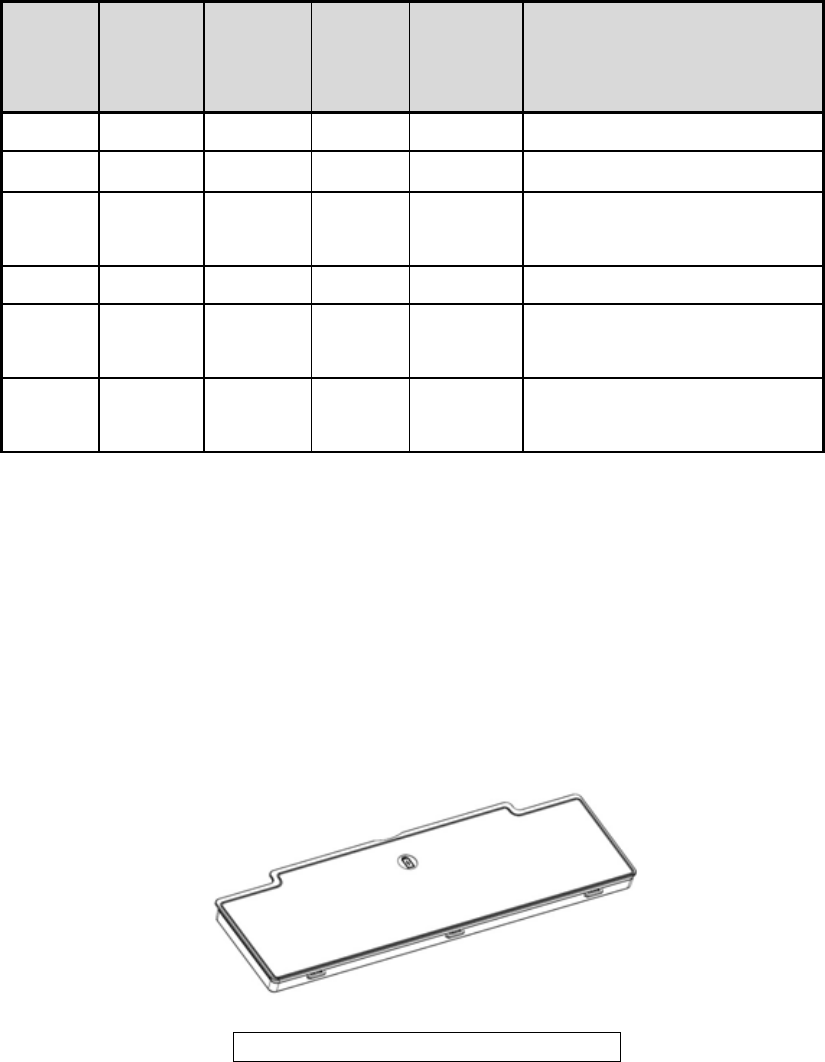
66
LED Status
DUT
on/off AC
adapter
in
Internal
Battery Green
LED Amber
LED Remark
Off X X Off Off System Off
Off V V Off On
Battery is charging
Off V V On Off
Battery is fully charged
(100%)
On V V Off On Battery is charging
On V V On Off
Battery is fully charged
(100%)
On V V Off On
Battery Low
(< 10 %)
A.2 Optional Accessories
A.2.1 External Battery
You can use an external battery to extend the power of your MIT-W101-A.
Battery specification: 2860 mAh, 11.1V
A.2.1.2 Installing the External Battery
1. Align and insert the battery on the MIT-W101-A.
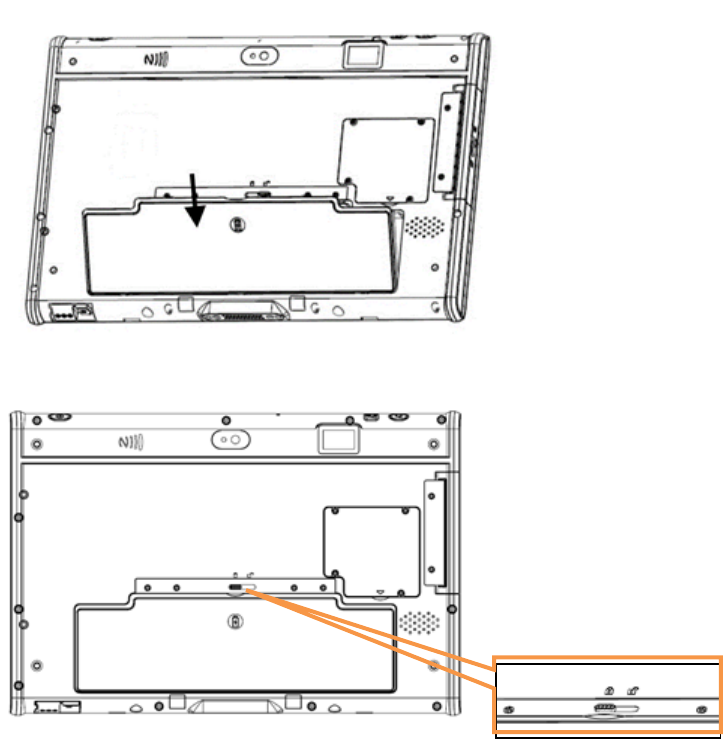
67
2. Lock to secure the battery once it is properly to be inserted.
A.2.1.2 Removing the External Battery
Repeat the above steps in reverse order to remove the battery.
A.2.2 Docking Station
You can use the docking station to dock the MIT-W101 to the place where you need
via standard 75 x 75 mm VESA hole on rear side. When docked, you can transfer data
from your MIT-W101 to another PC by COM port or USB port.
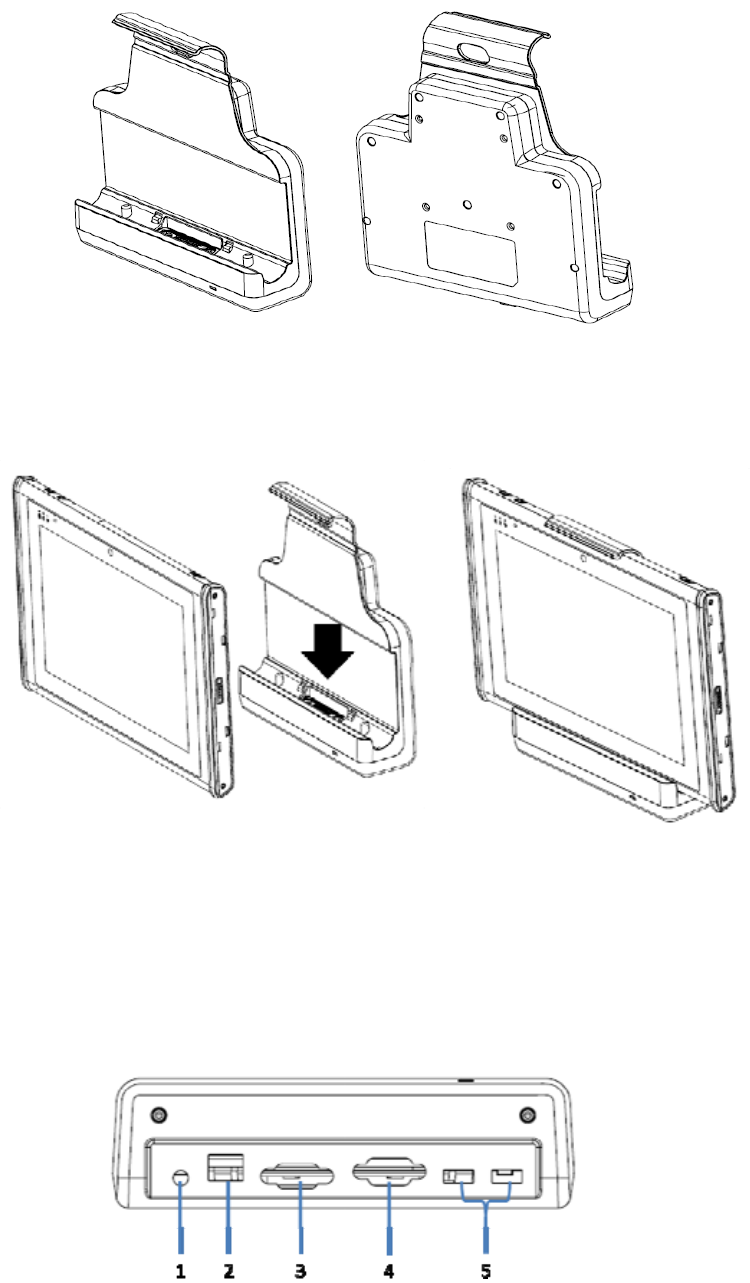
68
Attach the MIT-W101 to the docking stand as shown.
A.2.2.1 Docking Connectors
See below for the rear view of the docking and a description of all ports and
connectors.
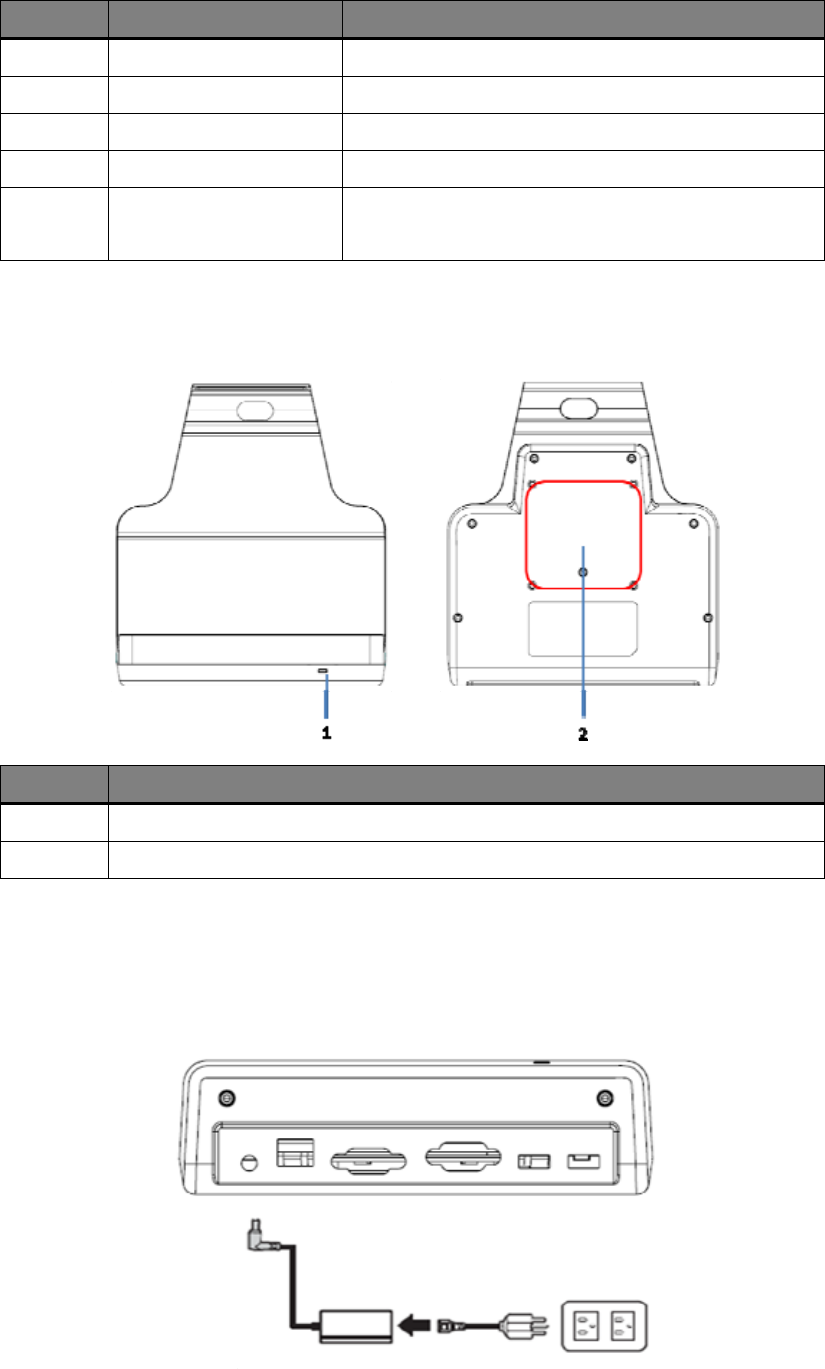
69
No. Component Function
1 Power jack Connect the AC adapter to provide power.
2 LAN port Connect an RJ-45 cable to access LAN connection.
3 VGA port Connect to display for 2nd display output
4 COM port Connect a serial cable to connect to another PC.
5 USB port USB 2.0 port x 2 , Connect USB connectors to transfer
data.
See below for the front view of the docking and a description of all ports and
connectors.
No. Function
1 LED indication / Device connected
2 Standard 75x75 VESA hole
A.2.2.2 Connecting Power to the Docking
Connect the AC power adapter to the docking and the mains as shown below.
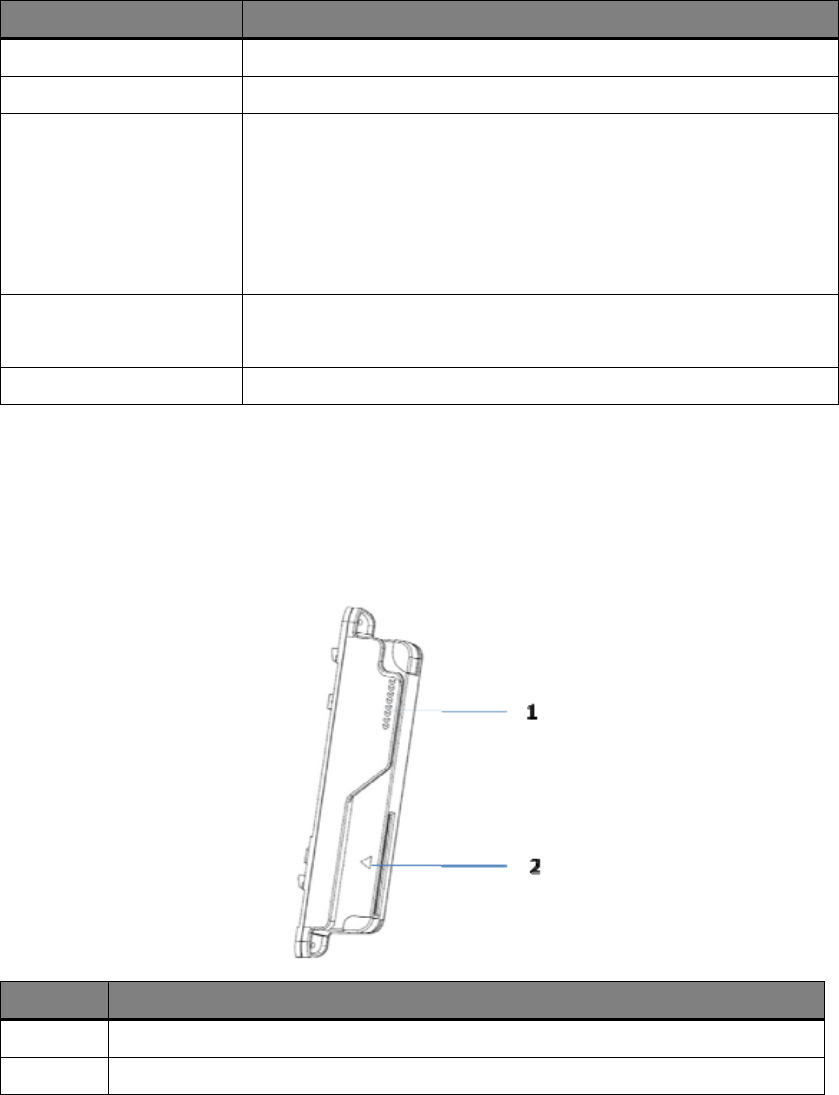
70
A.2.2.3 Docking Specifications
Feature Description
Feature Description
Product Name MIT-M101 Docking
Model Number MIT-M101-ACCVD
External I/O Interfaces
One LAN port
One COM port
One VGA port
Two USB 2.0 host connectors
One DC-in
Power AC Adapter: AC 100V-240V 50/60Hz,1.62A(max)
Output : 18Vdc/3.5A(max)/63W
Physical Size 224.7 (H) x 200 (W) x 56.4 (D) mm
A.2.3 Expansion Module
Built-in MSR and Smart Card Reader in expansion module.
No. Function
1 MSR
2 Smart Card Reader
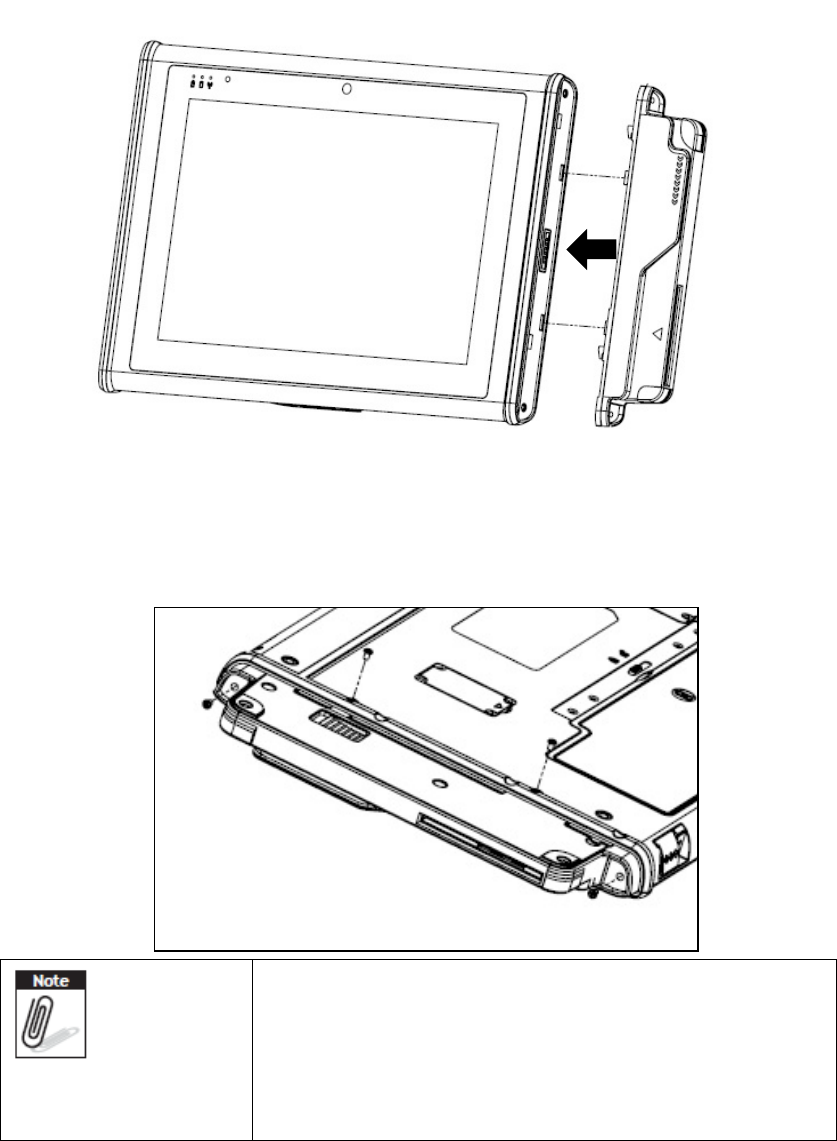
71
A2.3.1 Installing an Expansion module
1. Make sure the system is turned off.
2. Attach the expansion module connector to the MIT-W101.
3. Screw to secure the expansion module onto the MIT-W101.MIT-M
Please assure the expansion module was put on the right
position and the screws was fastened when install the
module on device. The expansion module might not work
if the device was not installed probably or damage by
drop.
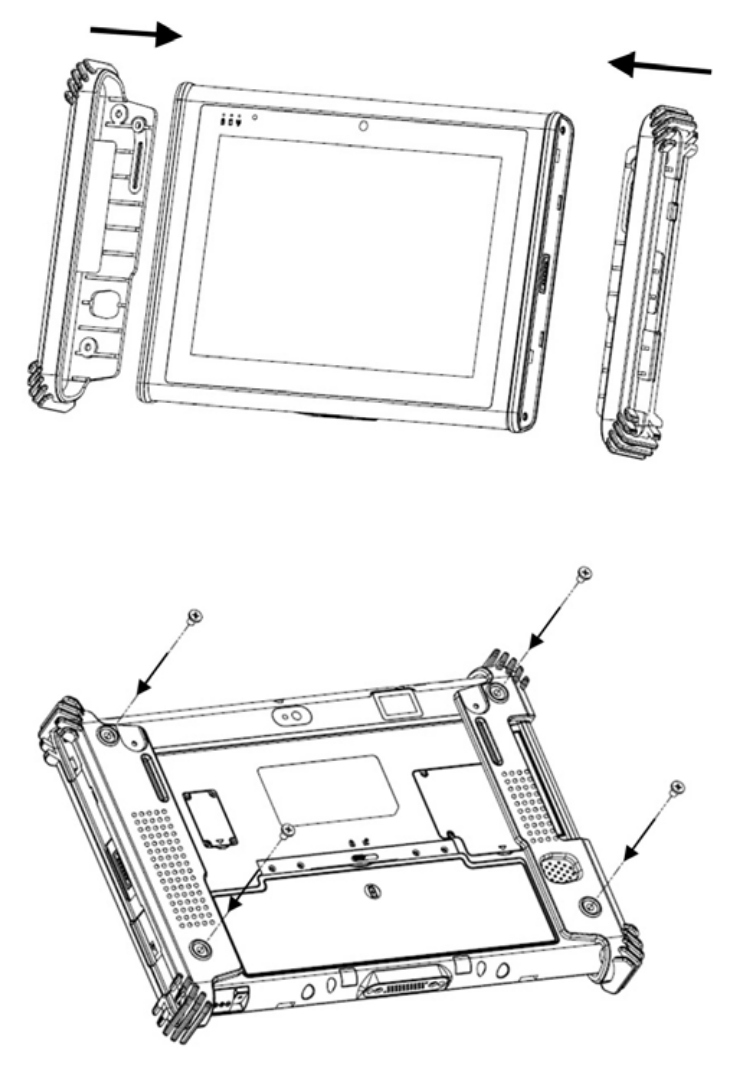
72
A2.4 Rubber Bumpers
To protect the housing case of MIT-W101, user can install the rubber bumpers.
A2.4.1 Installing the Rubber Bumpers
1. Install the rubber bumpers on the left and right side of the MIT-W101.
2. Make sure the rubber bumpers are aligned and locked on the indents.
3. Screw the rubber bumpers on left and right properly into the MIT-W101.
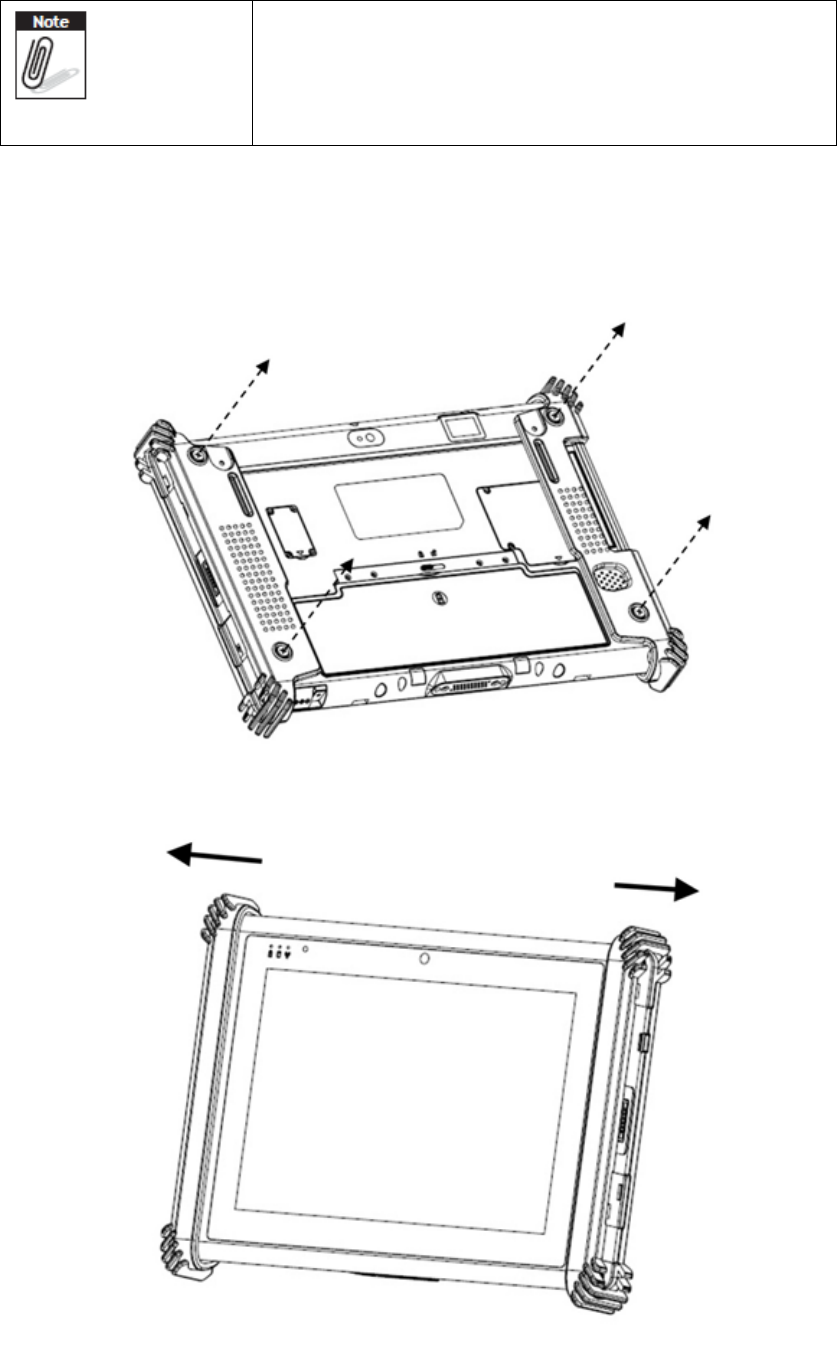
73
The Rubber bumper could provide well drop protection
when device fall from high place. Please assure the
rubber was put on the right position and the screws was
fastened when install the bumper on device.
A2.4.2 Removing the Rubber Bumpers
1. Unscrew the rubber bumpers from the rear of the tablet PC.
2. Remove the rubber bumpers on the left and right.
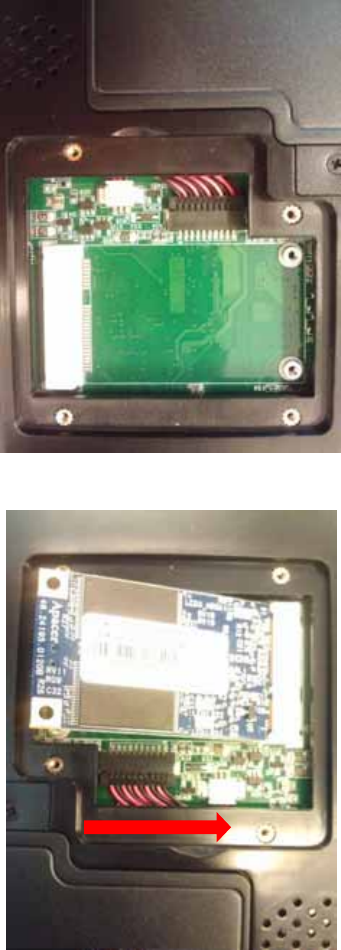
74
A.3 Installing an SSD
A.3.1.1 Inserting an SSD
You can insert an SDD to store data, which needs to be later transferred to another
machine, or to simply expand the storage capacity of the MIT-W101-A.
1. Open the SSD card compartment cover.
2. Insert the SDD, facing upwards, until it clicks into place.
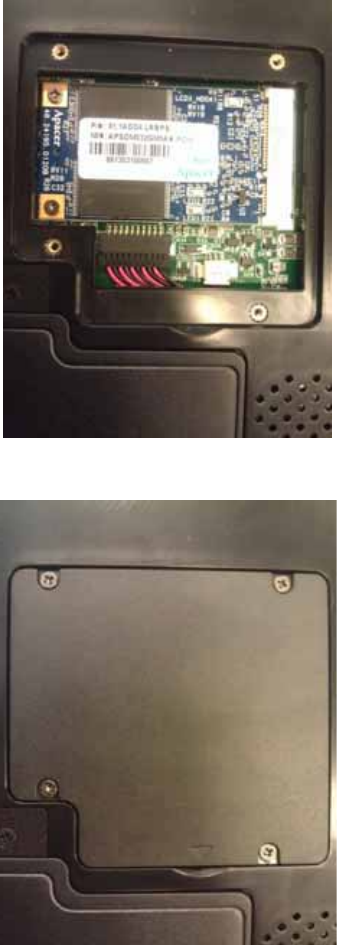
75
3. Screw and fix SSD.
4. Close the SDD compartment cover.
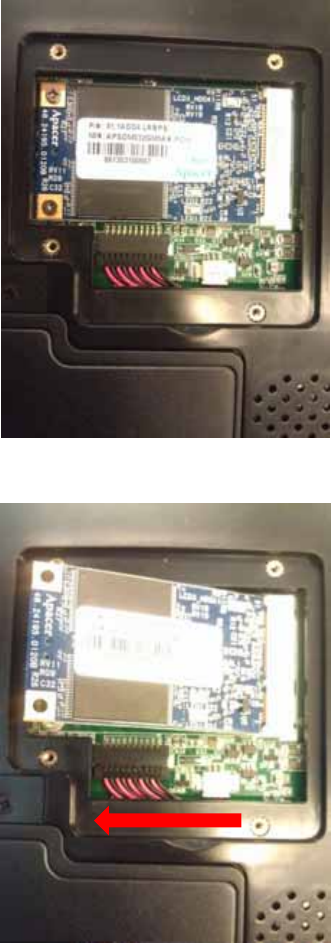
76
A.3.1.2 Removing an SSD
1. Open the SSD compartment cover.
2. Unscrew and remove SSD from the slot.
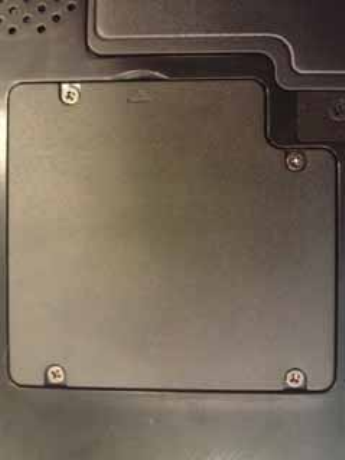
77
3. Close and screw the SSD card compartment cover.